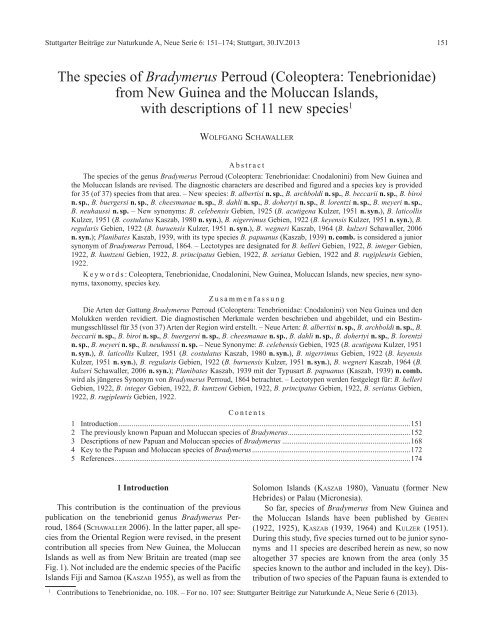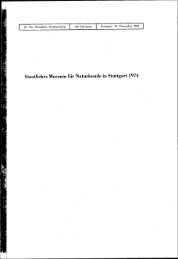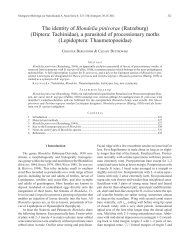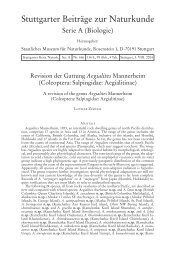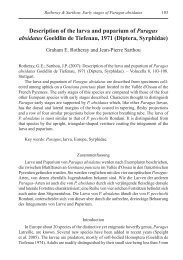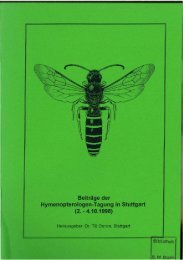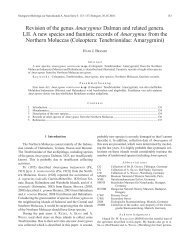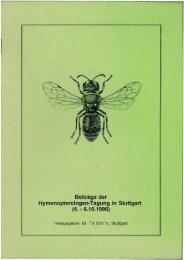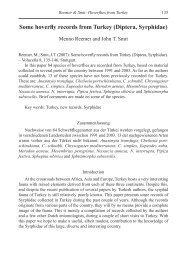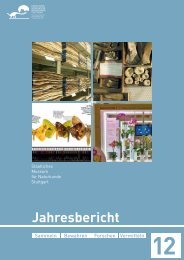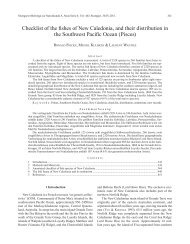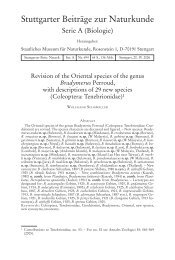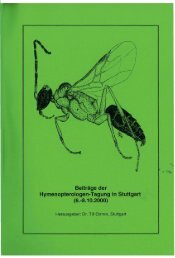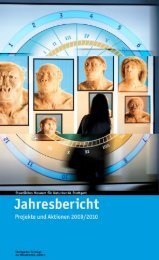The species of Bradymerus Perroud (Coleoptera: Tenebrionidae ...
The species of Bradymerus Perroud (Coleoptera: Tenebrionidae ...
The species of Bradymerus Perroud (Coleoptera: Tenebrionidae ...
You also want an ePaper? Increase the reach of your titles
YUMPU automatically turns print PDFs into web optimized ePapers that Google loves.
Stuttgarter Beiträge zur Naturkunde A, Neue Serie 6: 151–174; Stuttgart, 30.IV.2013151<strong>The</strong> <strong>species</strong> <strong>of</strong> <strong>Bradymerus</strong> <strong>Perroud</strong> (<strong>Coleoptera</strong>: <strong>Tenebrionidae</strong>)from New Guinea and the Moluccan Islands,with descriptions <strong>of</strong> 11 new <strong>species</strong> 1WOLFGANG SCHAWALLERAbstract<strong>The</strong> <strong>species</strong> <strong>of</strong> the genus <strong>Bradymerus</strong> <strong>Perroud</strong> (<strong>Coleoptera</strong>: <strong>Tenebrionidae</strong>: Cnodalonini) from New Guinea andthe Moluccan Islands are revised. <strong>The</strong> diagnostic characters are described and figured and a <strong>species</strong> key is providedfor 35 (<strong>of</strong> 37) <strong>species</strong> from that area. – New <strong>species</strong>: B. albertisi n. sp., B. archboldi n. sp., B. beccarii n. sp., B. biroin. sp., B. buergersi n. sp., B. cheesmanae n. sp., B. dahli n. sp., B. dohertyi n. sp., B. lorentzi n. sp., B. meyeri n. sp.,B. neuhaussi n. sp. – New synonyms: B. celebensis Gebien, 1925 (B. acutigena Kulzer, 1951 n. syn.), B. laticollisKulzer, 1951 (B. costulatus Kaszab, 1980 n. syn.), B. nigerrimus Gebien, 1922 (B. keyensis Kulzer, 1951 n. syn.), B.regularis Gebien, 1922 (B. buruensis Kulzer, 1951 n. syn.), B. wegneri Kaszab, 1964 (B. kulzeri Schawaller, 2006n. syn.); Planibates Kaszab, 1939, with its type <strong>species</strong> B. papuanus (Kaszab, 1939) n. comb. is considered a juniorsynonym <strong>of</strong> <strong>Bradymerus</strong> <strong>Perroud</strong>, 1864. – Lectotypes are designated for B. helleri Gebien, 1922, B. integer Gebien,1922, B. kuntzeni Gebien, 1922, B. principatus Gebien, 1922, B. seriatus Gebien, 1922 and B. rugipleuris Gebien,1922.Keywords: <strong>Coleoptera</strong>, <strong>Tenebrionidae</strong>, Cnodalonini, New Guinea, Moluccan Islands, new <strong>species</strong>, new synonyms,taxonomy, <strong>species</strong> key.ZusammenfassungDie Arten der Gattung <strong>Bradymerus</strong> <strong>Perroud</strong> (<strong>Coleoptera</strong>: <strong>Tenebrionidae</strong>: Cnodalonini) von Neu Guinea und denMolukken werden revidiert. Die diagnostischen Merkmale werden beschrieben und abgebildet, und ein Bestimmungsschlüsselfür 35 (von 37) Arten der Region wird erstellt. – Neue Arten: B. albertisi n. sp., B. archboldi n. sp., B.beccarii n. sp., B. biroi n. sp., B. buergersi n. sp., B. cheesmanae n. sp., B. dahli n. sp., B. dohertyi n. sp., B. lorentzin. sp., B. meyeri n. sp., B. neuhaussi n. sp. – Neue Synonyme: B. celebensis Gebien, 1925 (B. acutigena Kulzer, 1951n. syn.), B. laticollis Kulzer, 1951 (B. costulatus Kaszab, 1980 n. syn.), B. nigerrimus Gebien, 1922 (B. keyensisKulzer, 1951 n. syn.), B. regularis Gebien, 1922 (B. buruensis Kulzer, 1951 n. syn.), B. wegneri Kaszab, 1964 (B.kulzeri Schawaller, 2006 n. syn.); Planibates Kaszab, 1939 mit der Typusart B. papuanus (Kaszab, 1939) n. comb.wird als jüngeres Synonym von <strong>Bradymerus</strong> <strong>Perroud</strong>, 1864 betrachtet. – Lectotypen werden festgelegt für: B. helleriGebien, 1922, B. integer Gebien, 1922, B. kuntzeni Gebien, 1922, B. principatus Gebien, 1922, B. seriatus Gebien,1922, B. rugipleuris Gebien, 1922.Contents1 Introduction ...........................................................................................................................................................1512 <strong>The</strong> previously known Papuan and Moluccan <strong>species</strong> <strong>of</strong> <strong>Bradymerus</strong> .................................................................1523 Descriptions <strong>of</strong> new Papuan and Moluccan <strong>species</strong> <strong>of</strong> <strong>Bradymerus</strong> ....................................................................1684 Key to the Papuan and Moluccan <strong>species</strong> <strong>of</strong> <strong>Bradymerus</strong> ....................................................................................1725 References .............................................................................................................................................................1741 IntroductionThis contribution is the continuation <strong>of</strong> the previouspublication on the tenebrionid genus <strong>Bradymerus</strong> <strong>Perroud</strong>,1864 (SCHAWALLER 2006). In the latter paper, all <strong>species</strong>from the Oriental Region were revised, in the presentcontribution all <strong>species</strong> from New Guinea, the MoluccanIslands as well as from New Britain are treated (map seeFig. 1). Not included are the endemic <strong>species</strong> <strong>of</strong> the PacificIslands Fiji and Samoa (KASZAB 1955), as well as from theSolomon Islands (KASZAB 1980), Vanuatu (former NewHebrides) or Palau (Micronesia).So far, <strong>species</strong> <strong>of</strong> <strong>Bradymerus</strong> from New Guinea andthe Moluccan Islands have been published by GEBIEN(1922, 1925), KASZAB (1939, 1964) and KULZER (1951).During this study, five <strong>species</strong> turned out to be junior synonymsand 11 <strong>species</strong> are described herein as new, so nowaltogether 37 <strong>species</strong> are known from the area (only 35<strong>species</strong> known to the author and included in the key). Distribution<strong>of</strong> two <strong>species</strong> <strong>of</strong> the Papuan fauna is extended to1Contributions to <strong>Tenebrionidae</strong>, no. 108. – For no. 107 see: Stuttgarter Beiträge zur Naturkunde A, Neue Serie 6 (2013).
152 STUTTGARTER BEITRÄGE ZUR NATURKUNDE ANeue Serie 6Queensland, the Solomon Islands and Samoa respectively(B. crenatus, B. raucipennis), two <strong>species</strong> are known als<strong>of</strong>rom Vanuatu (B. lobicollis, B. solomonis), and only two<strong>species</strong> occur also in Sulawesi (B. celebensis, B. wegneri).<strong>The</strong> classification <strong>of</strong> the polymorphic genus <strong>Bradymerus</strong>within the tribe Cnodalonini as well as <strong>species</strong> characterswere already discussed by SCHAWALLER (2006). Statusand tribal assignment <strong>of</strong> the genus Apteromerus Blair,1928 with the <strong>species</strong> A. convexus (Fairmaire, 1849) andA. leopoldi Gebien, 1935 from the Pacific Islands and NewGuinea are still unclear. KASZAB (1955) considered ApteromerusBlair, 1928 together with Scotoderus <strong>Perroud</strong>, 1864as closest relatives <strong>of</strong> <strong>Bradymerus</strong> <strong>Perroud</strong>, 1864. <strong>The</strong> <strong>species</strong><strong>of</strong> Scotoderus were revised by KASZAB (1973).Acronyms <strong>of</strong> depositoriesCAPE Collection ANDREAS PÜTZ, EisenhüttenstadtCASH Collection ANDRÉ SKALE, H<strong>of</strong>/SaaleCAWW Collection ANDREAS WEIGEL, WernburgCKAO Collection Dr. KIYOSHI ANDO, OsakaCRGT Collection Dr. ROLAND GRIMM, NeuenbürgCSBC Collection STANISLAV BEČVÁŘ, České BudějoviceBMNH <strong>The</strong> Natural History Museum, London (MAX BARCLAY)HNHM Hungarian Natural History Museum, BudapestMNB(Dr. OTTÓ MERKL)Museum für Naturkunde, Berlin (BERND JÄGER,Dr. MANFRED UHLIG)MTD Museum für Tierkunde, Dresden (OLAF JÄGER)NHMB Naturhistorisches Museum, Basel (Dr. EVA SPRECHER,Dr. MICHEL BRANCUCCI †)NME Naturkundemuseum, Erfurt (MATTHIAS HARTMANN)NMP National Museum (Department <strong>of</strong> Entomology), Prague(Dr. JIŘÍ HÁJEK)SMNS Staatliches Museum für Naturkunde, StuttgartZMAN Zoölogisch Museum, Amsterdam (collection transferredto Leiden) (Dr. BEN BRUGGE)ZSM Zoologische Staatssammlung, München (Dr. MARTINBAEHR, Dr. MICHAEL BALKE)AcknowledgementsI thank all colleagues and friends (names see under depositories)for the trustful loan <strong>of</strong> specimens from the collections undertheir care. JOHANNES REIBNITZ (SMNS) prepared the photographsby using Leica DFC 480 digital camera on Leica MZ16 APOmicroscope, and subsequently processed the digital photographsusing Leica LAS s<strong>of</strong>tware. Dr. ROLAND GRIMM (Neuenbürg) andDr. OTTÓ MERKL (HNHM) as referees improved the manuscriptby their corrections and comments.2 <strong>The</strong> previously known Papuan and Moluccan <strong>species</strong><strong>of</strong> <strong>Bradymerus</strong><strong>Bradymerus</strong> batjanensis Gebien, 1925Diagnostic characters: GEBIEN (1925: 554)described this <strong>species</strong> to be similar to B. raucipennis,with somewhat different dorsal structure <strong>of</strong> pronotum andelytra, and somewhat different structure <strong>of</strong> the genae. Unfortunately,no figure is given in the original description.Remarks: Type material was not studied because itis missing in NHMB (FREY collection).Distribution: Bacan (= Batjan) Island near Halmahera(type locality) (Moluccan Islands).<strong>Bradymerus</strong> celebensis Gebien, 1925<strong>Bradymerus</strong> acutigena Kulzer, 1951 n. syn.Studied type material: Buru, station 6, 21.–24.IV.1921, leg. L. J. TOXOPEUS, holotype <strong>of</strong> B. acutigena ZMAN(damaged specimen, prothorax and head missing, sex unknown).– S Sulawesi (labelled as Celebes), coll. SCHAUFUSS, ♂ lectotype<strong>of</strong> B. celebensis MNB.Examined material: Same data as holotype, 1 ♂ZMAN (compared with holotype <strong>of</strong> B. acutigena by KASZAB in1977).Diagnostic characters: For description andfigures see SCHAWALLER (2006) under B. celebensis.Synonymy: Unfortunately, the holotype <strong>of</strong> B. acutigenais quite damaged, but fortunately another male nontypespecimen with same data was compared with the holotypeby KASZAB in 1977. When comparing these specimenswith the lectotype <strong>of</strong> B. celebensis (see SCHAWALLER 2006),no specific differences could be found. Thus, B. acutigenaKulzer, 1951 is considered a junior synonym <strong>of</strong> B. celebensisGebien, 1925.Distribution: Sulawesi (type locality <strong>of</strong> B. celebensis),Buru (type locality <strong>of</strong> B. acutigena) (MoluccanIslands).<strong>Bradymerus</strong> crassimargo Kulzer, 1951(Fig. 14)Studied type material: Buru, Wai Eno to Wai Temoen,700–1000 m, 3.II.1922, leg. L. J. TOXOPEUS, ♀ holotypeZMAN (left elytra missing).Diagnostic characters: Dorsal view seeFig. 14, dorsal side blackish without metallic shine, bodylength 10.0 mm. Genae not broader than eyes, frons withweak supraorbital furrows but without distinct supraorbitalkeels. Last 4 antennomeres forming a club. Anterior corners<strong>of</strong> pronotum distinctly protruding, lateral margin withfeeble crenulation, pronotal disc flat, with rough and partlyconfluent punctation; pronotum before base with distincttransverse impression. Elytra with punctural rows withoutstriae, punctures deeply impressed, intervals convex,intervals 1–4, 6, 8 with a row <strong>of</strong> small granules, intervals5, 7 keeled. Tibiae externally without distinct keels; modifications<strong>of</strong> male tibiae unknown (only female available).Aedeagus unknown.Remarks: Unfortunately, males are unknown, butbecause this <strong>species</strong> seems related to B. papuanus, the
SCHAWALLER, BRADYMERUS FROM NEW GUINEA AND THE MOLUCCAN ISLANDS 153male anterior tibiae very probably also have a distinct internaltooth before the middle.Distribution: Buru (type locality) (Moluccan Islands).<strong>Bradymerus</strong> crenatus (Pascoe, 1870)(Figs. 16, 40)Isostira crenata Pascoe, 1870.<strong>Bradymerus</strong> granaticollis Fairmaire, 1883 syn.Examined material: New Britain (labelled as Neubritannien),Ratum, leg. F. DAHL, 4 ex. MNB (B. granaticollis det.GEBIEN). – New Britain (labelled as Bismarck Archipel), Ratum,1896–1897, leg. F. DAHL, 1 ex. MNB. – Halmahera, Wangonira,28.III.1995, leg. W. LORENZ, 2 ex. CRGT. – Seram, Air Basar,6 km E Wahei, 5.XI.1998, leg. S. BILÝ, 1 ex. NMP. – Seram,Solea, 12 km SE Wahai, 17.I.–6.II.1997, leg. S. BILÝ, 2 ex. SMNS,1 ex. HNHM. – Seram, 35 km E Pasahari, 24.–30.X.1998, leg. J.HORÁK, 6 ex. ZSM, 2 ex. SMNS, 1 ex. CRGT. – Mangole Island(W Moluccan Islands), VII.–XII.1977, leg. V. & G. WEGENER,2 ex. NHMB. – West Papua, Raja Ampat Prov., Salawati Island,Kalobo, 24.–28.I.2004, leg. A. SKALE, 1 ex. CRGT. – West Papua,Manokwari Prov., Ransiki, Mayuby, 26.–30.IX.1990, leg. A. RIE-DEL, 5 ex. SMNS. – West Papua, Manokwari Prov., Gunung Meja,200 m, 19.IV.1993, leg. A. RIEDEL, 1 ex. SMNS. – West Papua,Cyclops Mts., Sabron, camp 2, 2000 ft., VII.1936, leg. L. E.CHEESMAN, 1 ex. BMNH. – West Papua, Jayapura, Sentani, CyclopsMts., 400 m, 19.–21.IX.1990, leg. A. RIEDEL, 3 ex. SMNS.– West Papua, Jayapura, Sentani, Cyclops Mts., 300–450 m,31.X.1992, leg. A. RIEDEL, 7 ex. SMNS. – West Papua, Biak Island,Sepse, 3.X.1990, leg. A. RIEDEL, 2 ex. SMNS. – West Papua,Biak Island, Adadikam, XII.2006, leg. O. Mehl, 1 ex. HNHM. –West Papua, Sorong, Dusun Meibo, 100–150 m, 19.I.2001, leg.A. RIEDEL, 1 ex. SMNS. – West Papua, Fakfak, 2 km E airstrip,16.–18.VII.1996, leg. P. SCHÜLE & P. STÜBEN, 1 ex. SMNS. – WestPapua, Nabire to Mapia, Unipo, 24.VII.1996, leg. P. SCHÜLE & P.STÜBEN, 3 ex. SMNS. – West Papua, Sorong, 29.IX.–6.X.1992,leg. B. BALÁZS, 1 ex. HNHM. – West Papua, Japen (labelled asYapen) Island, Serui, 28.XII.2006 –9.I.2007, leg. S. BILÝ, 1 ex.NMP. – West Papua, 130 km SE Kaimana, Omba (= Yamor) river,10–20 km from coast, 9.–11.II.2011, leg. A. SKALE, 1 ex. CASH.– West Papua, road 10 km NE Kaimana, 40 m, 1.II.2011, leg.A. SKALE, 2 ex. CASH. – Papua New Guinea, Kapala, Madang,650–1500 m, no further data, 2 ex. HNHM. – Papua New Guinea,Kokoda, 1200 ft., VIII.–X.1933, leg. L. E. CHEESMAN, 6 ex.BMNH. – Papua New Guinea, Morobe Prov., Kaiapit, XII.1978,leg. W. G. ULLRICH, 1 ex. CKAO. – Papua New Guinea, Karimui,III.1974, leg. J. SEDLACEK, 5 ex. HNHM. – Papua New Guinea,Mt. Missim, II.1974, leg. J. SEDLACEK, 2 ex. HNHM. – Papua NewGuinea, Bulolo, 700 m, II.1974, leg. J. SEDLACEK, 1 ex. HNHM.Diagnostic characters: Dorsal view seeFig. 16, dorsal side blackish without metallic shine, bodylength 6.3–8.0 mm. Genae distinctly broader than eyes,frons with distinct supraorbital furrows and with distinctsupraorbital keels. Last 6 antennomeres forming a club.Anterior corners <strong>of</strong> pronotum distinctly protruding, lateralmargin with feeble crenulation, pronotal disc convex, withrough and confluent punctation, before base with a smallmedial impunctate field, between punctures with granules;pronotum medially with distinct longitudinal impression.Elytra with punctural rows without striae, puncturesdeeply impressed, intervals distinctly convex and regularwith complete high keels, keels slightly sinuate. Tibiae externallywith distinct keels; male tibiae without modifications.Aedeagus see Fig. 40.Distribution: Halmahera, Seram, Bacan (= Batjan),Banda, Mangole (all Moluccan Islands); New Guinea,New Britain, Duke <strong>of</strong> York Island (type locality <strong>of</strong> B. granaticollis);Queensland (type locality <strong>of</strong> B. crenatus); SolomonIslands, Samoa.<strong>Bradymerus</strong> doleschalli Kaszab, 1964(Figs. 4, 50)Studied type material: Amboina, 1859, leg. L. DOLE-SCHALL, ♂ holotype and 1 paratype HNHM.Examined material: Amboina, XI.1923, leg. C. J.BROOKS, 1 ex. BMNH. – Amboina, Laihatu, Soya, 11.–12.X.1998,leg. J. HORÁK, 2 ex. ZSM. – Ambon, VIII.1999, 1 ex. CKAO. –Seram, Air Basar, 6 km E Wahei, 5.XI.1998, leg. S. BILÝ, 1 ex.NMP. – Seram, 12 km SE Wahai, Solea, 17.I.–6.II.1997, leg. S.BILÝ, 6 ex. CSBC, 5 ex. ZSM, 3 ex. SMNS. – Seram, 12 km SEWahai, Solea, 16.–21.X.1998, leg. J. HORÁK, 4 ex. ZSM. – Seram,X.–XI.1909, leg. W. STALKER, 1 ex. BMNH.Diagnostic characters: Dorsal view see Fig. 4,dorsal side blackish without metallic shine, body length9.5–11.0 mm. Genae not broader than eyes, frons with distinctsupraorbital furrows but without distinct supraorbitalkeels. Last 5 antennomeres forming a club. Anterior corners<strong>of</strong> pronotum distinctly protruding, lateral margin withfeeble crenulation, pronotal disc flat, with rough and partlyconfluent punctation, before base punctures more separate,between punctures with granules; pronotum before basewith shallow transverse impression. Elytra with puncturalrows without striae, punctures deeply impressed, intervals1–2 distinctly convex and with a row <strong>of</strong> feeble granules, intervals3–8 with complete keels. Tibiae externally withoutdistinct keels; anterior male tibiae internally with longitudinalstripe <strong>of</strong> densely set light setae. Aedeagus see Fig. 50.Distribution: Amboina island (= Ambon) (typelocality), Seram.<strong>Bradymerus</strong> helleri Gebien, 1922(Fig. 5)Studied type material: Papua New Guinea, Kaiser-Wilhelms-Land, Astrolabe Bay, Bongu, without date, 1 ♀ syntypeMTD, here designated as lectotype.Examined material: Papua New Guinea, Misima (labelledMissima) Island, 250 m, 20.IX.1982, leg. J. SEDLACEK, 1 ♀HNHM.
154 STUTTGARTER BEITRÄGE ZUR NATURKUNDE ANeue Serie 6Diagnostic characters: Dorsal view see Fig. 5,dorsal side blackish without metallic shine, body length10.8–12.5 mm. Genae not broader than eyes, frons withdistinct supraorbital furrows but without distinct supraorbitalkeels. Last 5 antennomeres forming a club. Anteriorcorners <strong>of</strong> pronotum protruding, lateral margin with feeblecrenulation, pronotal disc flat, with dense but not confluentpunctation, before base punctures more separate, betweenpunctures with a few granules; pronotum before base withshallow transverse impression. Elytra with punctural rowswithout striae, punctures deeply impressed, intervals distinctlyconvex and regular with a row <strong>of</strong> distinct granules.Tibiae externally without distinct keels; modifications <strong>of</strong>male tibiae unknown (only females available). Aedeagusunknown.Remarks: <strong>The</strong> newly collected female from MisimaIsland has the dorsal tubercles somewhat smaller than inthe female lectotype, all other characters coincide.Distribution: New Guinea (type locality Bongu)including Misima Island (Louisiade Archipelago).<strong>Bradymerus</strong> integer Gebien, 1922(Figs. 20, 42)Studied type material: Dammer Island, without date,1 ♀ syntype NHMB, here designated as lectotype.Examined material: Dammer (labelled as Damma) Island,without date, leg. J. J. WALKER, 1 ex. BMNH, 1 ex. SMNS.– Dammer Island, 3 ex. MNB. – Timor Island, Dilli, 2500 ft.,leg. W. DOHERTY, 2 ex. BMNH. – Timor Island, Faku Lés, leg.W. DOHERTY, 2 ex. BMNH. – Adonara Island E Flores, leg. W.DOHERTY, 2 ex. BMNH. – Alor Island, Pura, leg. W. DOHERTY,1 ex. BMNH. – Tanimbar (labelled as Tenimber) Island, Jandema,leg. W. DOHERTY, 2 ex. BMNH. – Buru Island, Ilat, leg. W. DO-HERTY, 3 ex. BMNH. – Admirality Islands, leg. S. ROCHOLL, 1 ex.HNHM. – Bacan Island, valley 3 km S Labuha, 40 m, 13.I.2006,leg. A. SKALE, 3 ex. NME, 1 ex. CRGT. – S Halmahera, 2–3 km NDolik, 18.–20.I.2006, leg. A. SKALE, 1 ex. SMNS. – West Papua,Nusi Island near Biak Island, 12.VIII.1996, leg. P. SCHÜLE & P.STÜBEN, 1 ex. SMNS. – West Papua, Raja Ampat Prov., BatantaIsland, Wallebet, 18.–21.I.2004, leg. A. SKALE, 1 ex. CRGT. –Papua New Guinea, Stephansort, Astrolabe Bay, 1900, leg. L.BIRÓ, 2 ex. HNHM. – Papua New Guinea, Morobe Prov., Sattelberg,Huon Golf, 1899, leg. S. BIRÓ, 1 ex. HNHM. – Papua NewGuinea, Berlinhafen, Seleo, 1896, leg. L. BIRÓ, 1 ex. HNHM.Diagnostic characters: Dorsal view seeFig. 20, dorsal side blackish without metallic shine, bodylength 6.0–6.5 mm. Genae not broader than eyes, fronswith distinct supraorbital furrows but without distinct supraorbitalkeels. Last 6 antennomeres forming a club. Anteriorcorners <strong>of</strong> pronotum distinctly protruding, lateralmargin with feeble crenulation, pronotal disc convex, withrough and confluent punctation, between punctures with afew granules; pronotum medially with distinct longitudinalimpression. Elytra with punctural rows without striae,punctures deeply impressed, intervals distinctly convexand regular with complete keels, keels slightly sinuate.Tibiae externally without distinct keels; male tibiae withoutmodifications. Aedeagus see Fig. 42.Remarks: This <strong>species</strong> is quite similar in externalcharacters and also in the aedeagus to the widespread B.clathratus Schaufuss, 1887 (SCHAWALLER 2006: figs. 16,87), but in B. integer the pronotal punctation is rougherand the elytral keels are distinctly higher.Distribution: Dammer Island NE Timor (type locality),Timor, Adonara, Alor, Buru, Bacan, Halmahera,Admirality Islands, New Guinea including Batanta Island.<strong>Bradymerus</strong> kuntzeni Gebien, 1922(Fig. 19)Studied type material: Papua New Guinea (labelledas D. N. Guinea), Mäanderberg, 670 m, 19.–31.VII.1913, leg.J. BÜRGERS, 1 ♀ syntype MNB, here designated as lectotype. –Papua New Guinea (labelled as D. N. Guinea), Mäanderberg,670 m, 21.–30.VIII.1913, leg. J. BÜRGERS, 1 ♀ paralectotypeMNB.Examined material: West Papua, Manokwari Prov.,Mokwam (Siyoubrig), 1400–1800 m, 24.–28.II.2007, leg. A.WEIGEL, 1 ♀ CRGT. – West Papua, Manokwari Prov., 18 km NWRansiki, Anggi Gida, Kampung Itkau, 1890 m, 4.III.2007, leg. A.WEIGEL, 1 ♀ SMNS.Diagnostic characters: Dorsal view seeFig. 19, dorsal side blackish without metallic shine, bodylength 7.5–8.5 mm. Genae not broader than eyes, frons withdistinct supraorbital furrows but without distinct supraorbitalkeels. Last 5 antennomeres forming a club. Anteriorcorners <strong>of</strong> pronotum distinctly protruding, lateral marginwith feeble crenulation, pronotal disc convex, with denseand partly confluent punctation, before base puncturesmore separate, between punctures with a few fine granules;pronotum before base with shallow transverse impression.Elytra with punctural rows without striae, punctures deeplyimpressed, all intervals distinctly convex and regular witha row <strong>of</strong> distinct granules. Tibiae externally without distinctkeels; modifications <strong>of</strong> male tibiae unknown (onlyfemales available). Aedeagus unknown.Distribution: New Guinea (type locality Mäanderberg).<strong>Bradymerus</strong> laticollis Kulzer, 1951(Figs. 17, 43)<strong>Bradymerus</strong> costulatus Kaszab, 1980 n. syn.Studied type material: Buru, station 9, 20.VI.–10.VII.1921, leg. L. J. TOXOPEUS, ♂ holotype <strong>of</strong> B. laticollisZMAN. – Buru, station 9, 26.IV.–10.VII.1921, leg. L. J.TOXOPEUS, 9 paratypes <strong>of</strong> B. laticollis ZMAN. – Buru, station 9,
SCHAWALLER, BRADYMERUS FROM NEW GUINEA AND THE MOLUCCAN ISLANDS 155Fig. 1. <strong>The</strong> investigated area with records <strong>of</strong> <strong>Bradymerus</strong>: New Guinea including small adjacent islands (Biak, Japen, Waigeo, Salawati,Batanta), New Britain, and the Moluccan Islands (Halmahera, Bacan, Seram, Ambon, Damar, Aru, Kai, Mangole).20.VI.–10.VII.1921, leg. L. J. TOXOPEUS, 1 paratype <strong>of</strong> B. laticollis(sex not examined) NHMB.Examined material: West Papua, Biak Island, Korim,Wouna, 21.–22.IV.1993, leg. A. RIEDEL, 1 ex. SMNS. – WestPapua, Testega, 1100–1200 m, 11.IV.1993, leg. A. RIEDEL, 1 ex.SMNS. – Papua New Guinea, Karimui, III.1974, leg. J. SED-LACEK, 1 ex. HNHM.Diagnostic characters: Dorsal view seeFig. 17, dorsal side blackish without metallic shine, bodylength 7.0–8.5 mm. Genae not broader than eyes, fronswith distinct supraorbital furrows but without distinct supraorbitalkeels. Last 6 antennomeres forming a club. Anteriorcorners <strong>of</strong> pronotum distinctly protruding, lateralmargin with feeble crenulation, pronotal disc convex, withrough and confluent punctation, between punctures withoutgranules; pronotum medially with longitudinal impression.Elytra with punctural rows without striae, puncturesdeeply impressed, intervals distinctly convex and regularwith complete keels, keels slightly sinuate. Tibiae externallywith distinct keels; male posterior tibiae internallywith a fine longitudinal stripe <strong>of</strong> densely set light setae,male posterior femora ventrally with a small patch <strong>of</strong>densely set light setae. Aedeagus see Fig. 43.Synonymy: <strong>The</strong> description <strong>of</strong> B. costulatus byKASZAB (1980) including the detailed figure shows no specificdifferences to type material <strong>of</strong> B. laticollis, thus B.costulatus Kaszab, 1980 is considered a junior synonym <strong>of</strong>B. laticollis Kulzer, 1951.Distribution: Buru (type locality <strong>of</strong> B. laticollis)(Moluccan Islands), New Guinea (type locality Wau <strong>of</strong> B.costulatus) including Biak Island, New Britain, RennellIslands.<strong>Bradymerus</strong> lobicollis Gebien, 1922(Fig. 29)Examined material: Vanuatu (labelled as New Hebrides),Espiritu Santo (labelled as Santo), VIII.–IX.1929, leg. L. E.CHEESMAN, 2 ex. BMNH, 1 ♀ SMNS.Diagnostic characters: Dorsal view seeFig. 29, dorsal side blackish without metallic shine, bodylength 5.8 mm. Genae slightly broader than eyes, frons withdistinct supraorbital furrows but without distinct supraorbitalkeels. Last 6 antennomeres forming a club. Anteriorcorners <strong>of</strong> pronotum extremely protruding, lateral marginwith feeble crenulation, pronotal disc convex, with roughand confluent punctation, before base punctures moreseparate, between punctures with high and laterally keeledgranules; pronotum before base with shallow transverseimpression and medially and on each side with distinct longitudinalimpression. Elytra with punctural rows withoutstriae, punctures normally impressed, intervals 1, 2 withdistinct elongate granules, intervals 3–8 with distinctlyelongate granules partly forming keels. Tibiae externallyeach with 3 keels; modifications <strong>of</strong> male tibiae unknown(only female available). Aedeagus unknown.Remarks: <strong>The</strong> three-keeled tibia is a synapomorphiccharacter occurring also in some <strong>species</strong> from New Guinea(B. albertisi n. sp., B. cheesmanae n. sp., B. meyeri n. sp.)and from Sulawesi (B. sprecherae Schawaller, 2006).– Type material was not studied because it is missing inNHMB (FREY collection).Distribution: New Guinea (type locality FriedrichWilhelmshafen, now Madang), Vanuatu (former New Hebrides).
156 STUTTGARTER BEITRÄGE ZUR NATURKUNDE ANeue Serie 6Figs. 2–7. <strong>Bradymerus</strong> spp., dorsal views. – 2. B. buergersi n. sp., ♂ holotype SMNS. 3. B. dahli n. sp., ♀ holotype MNB. 4. B. doleschalli,♂ holotype HNHM. 5. B. helleri, ♀ lectotype MTD. 6. B. macrogonus, ♂ holotype MTD. 7. B. neuhaussi n. sp., ♀ paratypeSMNS. – Scale: 2 mm.
SCHAWALLER, BRADYMERUS FROM NEW GUINEA AND THE MOLUCCAN ISLANDS 157Figs. 8–14. <strong>Bradymerus</strong> spp., dorsal views. – 8. B. plicicollis, ♂ non-type SMNS. 9. B. nigerrimus, ♂ non-type SMNS. 10. B. principatus,♂ non-type SMNS. 11. B. rugipleuris, ♂ non-type SMNS. 12. B. novaeguineense, ♀ holotype HNHM. 13. B. sculptilis, ♂ non-typeSMNS. 14. B. crassimargo, ♀ holotype ZMAN. – Scale: 2 mm.
158 STUTTGARTER BEITRÄGE ZUR NATURKUNDE ANeue Serie 6Figs. 15–20. <strong>Bradymerus</strong> spp., dorsal views. – 15. B. cheesmanae n. sp., ♂ holotype SMNS. 16. B. crenatus, ♂ non-type SMNS. 17. B.laticollis, ♂ non-type SMNS. 18. B. semiasperatus, ♂ non-type NHMB. 19. B. kuntzeni, ♀ lectotype MNB. 20. B. integer, ♂ non-typeSMNS. – Scale: 2 mm.
SCHAWALLER, BRADYMERUS FROM NEW GUINEA AND THE MOLUCCAN ISLANDS 159Figs. 21–26. <strong>Bradymerus</strong> spp., dorsal views. – 21. B. papuanus, ♂ non-type SMNS. 22. B. raucipennis, ♂ non-type SMNS. 23. B. regularis,♂ non-type SMNS. 24. B. dohertyi n. sp., ♂ holotype SMNS. 25. B. toxopei, ♂ non-type SMNS. 26. B. ternatensis, ♀ holotypeZMAN. – Scale: 2 mm.
160 STUTTGARTER BEITRÄGE ZUR NATURKUNDE ANeue Serie 6Figs. 27–32. <strong>Bradymerus</strong> spp., dorsal views. – 27. B. archboldi n. sp., ♂ holotype HNHM. 28. B. lorentzi n. sp., ♀ holotype HNHM.29. B. lobicollis, ♀ non-type SMNS. 30. B. beccarii n. sp., ♂ holotype SMNS. 31. B. solomonis, ♂ paratype HNHM. 32. B. albertisin. sp., ♂ holotype SMNS. – Scale: 2 mm.
SCHAWALLER, BRADYMERUS FROM NEW GUINEA AND THE MOLUCCAN ISLANDS 161Figs. 33–34. <strong>Bradymerus</strong> spp., dorsal views. – 33. B. biroi n. sp., ♂ holotype SMNS. 34. B. meyeri n. sp., ♀ holotype CRGT. – Scale:2 mm.<strong>Bradymerus</strong> macrogonus Gebien, 1922(Figs. 6, 51)Studied type material: Papua New Guinea, Kaiser-Wilhelmsland,Torricelli Mts., 640 m, without date, leg. O.SCHLAGINHAUFEN, ♂ holotype MTD.Diagnostic characters: Dorsal view see Fig. 6,dorsal side blackish without metallic shine, body length12.3 mm. Genae broader than eyes, frons with distinct supraorbitalfurrows and with feeble supraorbital keels. Last5 antennomeres forming a club. Anterior corners <strong>of</strong> pronotumdistinctly protruding, lateral margin with distinct crenulation,pronotal disc convex, with rough and confluentpunctation, before base in the middle with a small impunctatefield, between punctures with high granules; pronotummedially with longitudinal impression. Elytra with puncturalrows without striae, punctures normally impressed,intervals convex and with a row <strong>of</strong> distinct elongate granules,in intervals 3, 5, 7, 8 granules higher and more confluent,nearly keeled. Tibiae externally with distinct keels;male tibiae without modifications. Aedeagus see Fig. 51.Remarks: B. macrogonus is quite similar to thewidespread and common B. principatus concerning largebody size, dorsal structure and shape <strong>of</strong> pronotum, as wellas elytral structure (compare Figs. 6, 10), but differs by thegenae distinctly broader than eyes, the antennae with thelast 5 antennomeres forming a club, the tibiae with distinctexternal keels, and the different aedeagus (Figs. 51, 56).See also under B. buergersi n. sp. and B. neuhaussi n. sp.Distribution: New Guinea (type locality TorricelliMts.).<strong>Bradymerus</strong> nigerrimus Gebien, 1922(Figs. 9, 54)<strong>Bradymerus</strong> keyensis Kulzer, 1951 n. syn.Studied type material: Papua New Guinea (labelledas D. N. Guinea), But II, 1910, leg. H. SCHOEDE, holotype <strong>of</strong> B. nigerrimus(sex not examined) MNB. – Key Islands, 1 ♀ paratype<strong>of</strong> B. keyensis NHMB.Examined material: Papua New Guinea, Sorono, leg.L. M. D’ALBERTIS, 1 ex. NHMB (det. GEBIEN). – West Papua, Fakfak,2 km E airstrip, 16.–18.VII.1996, leg. P. SCHÜLE & P. STÜBEN,1 ex. SMNS. – West Papua, Waigeo Island, Yembekaki, 180 m,20.–23.I.2001, leg. A. RIEDEL, 2 ex. SMNS. – West Papua, NabireDistr., Mt. Botak near Kwatisore, 150 m, VIII.1998, leg.M. WENDESI, 1 ex. CRGT. – Key Islands, 1 ex. HNHM. – KeyIslands, 10 km W Tual, Ohoidertawun, 17.–20.II.2011, leg. A.SKALE & A. WEIGEL, 6 ex. NME, 2 ex. CASH, 2 ex. CRGT, 2 ex.SMNS. – Aru Islands, Wokam Island, Samang, 15.II.2011, leg. A.WEIGEL, 1 ex. NME.Diagnostic characters: Dorsal view see Fig. 9,dorsal side blackish without metallic shine, body length9.5–12.8 mm. Genae not broader than eyes, frons with dis-
162 STUTTGARTER BEITRÄGE ZUR NATURKUNDE ANeue Serie 6Figs. 35–58. <strong>Bradymerus</strong> spp., aedeagi. – 35. B. albertisi n. sp., ♂ holotype SMNS. 36. B. archboldi n. sp., ♂ holotype HNHM. 37. B.beccarii n. sp., ♂ holotype SMNS. 38. B. biroi n. sp., ♂ holotype SMNS. 39. B. cheesmanae n. sp., ♂ holotype SMNS. 40. B. crenatus,♂ non-type SMNS. 41. B. dohertyi n. sp., ♂ holotype SMNS. 42. B. integer, ♂ non-type SMNS. 43. B. laticollis, ♂ holotype ZMAN.44. B. papuanus, ♂ non-type SMNS. 45. B. raucipennis, ♂ non-type SMNS. 46. B. regularis, ♂ non-type SMNS. 47. B. toxopei, ♂non-type SMNS. 48. B. solomonis, ♂ paratype HNHM. 49. B. buergersi n. sp., ♂ holotype SMNS. 50. B. doleschalli, ♂ holotypeHNHM. 51. B. macrogonus, ♂ holotype MTD. 52. B. neuhaussi n. sp., ♂ holotype SMNS. 53. B. semiasperatus, ♂ non-type NHMB.54. B. nigerrimus, ♂ non-type NHMB. 55. B. plicicollis, ♂ non-type SMNS. 56. B. principatus, ♂ non-type SMNS. 57. B. rugipleuris,♂ non-type SMNS. 58. B. sculptilis, ♂ paratype NHMB. – Scale: 1 mm.
SCHAWALLER, BRADYMERUS FROM NEW GUINEA AND THE MOLUCCAN ISLANDS 163tinct supraorbital furrows but without distinct supraorbitalkeels. Last 5 antennomeres forming a club. Anterior corners<strong>of</strong> pronotum distinctly protruding, lateral margin withfeeble crenulation, pronotal disc flat, with dense and partlyconfluent punctation, before base punctures more separate,between punctures without granules; pronotum before basewith shallow transverse impression. Elytra with puncturalrows without striae, punctures deeply impressed, intervals1–2 distinctly convex and with a row <strong>of</strong> feeble granules, intervals3–8 with complete and slightly sinuate keels. Tibiaeexternally without distinct keels; anterior male tibiae internallywith two narrow longitudinal stripes <strong>of</strong> densely setlight setae. Aedeagus see Fig. 54.Synonymy: B. keyensis Kulzer, 1951 is consideredas junior synonym <strong>of</strong> B. nigerrimus Gebien, 1922 becausethe reexamined type material <strong>of</strong> both taxa shows no distinctspecific differences. KULZER (1951) separated themmainly by the shape <strong>of</strong> the antennomeres, which cannot beverified by the present author.Distribution: New Guinea (type locality But <strong>of</strong> B.nigerrimus) including Waigeo Island, Key Islands (type locality<strong>of</strong> B. keyensis), Aru Islands.<strong>Bradymerus</strong> novaeguineense Kaszab, 1939(Fig. 12)Studied type material: Papua New Guinea, FriedrichWilhelmshafen, 1901, leg. L. BIRÓ, ♀ holotype HNHM.Diagnostic characters: Dorsal view seeFig. 12, dorsal side blackish without metallic shine, head,pronotum and elytra with short light setae, body length9.8 mm. Genae not broader than eyes, frons with distinctsupraorbital furrows but without distinct supraorbital keels.Last 5 antennomeres forming a club. Anterior corners <strong>of</strong>pronotum distinctly protruding, lateral margin with feeblecrenulation, pronotal disc convex, with dense but notconfluent punctation, between punctures without granules;pronotum before base with shallow transverse impression.Elytra with punctural rows without striae, punctures deeplyimpressed, all intervals distinctly convex and without granulesor keels. Tibiae externally without distinct keels; modifications<strong>of</strong> male tibiae unknown (only female available).Aedeagus unknown.Remarks: <strong>The</strong> generic assignment <strong>of</strong> this <strong>species</strong> isdoubtful, because its general habitus has a somewhat intermediateposition between <strong>Bradymerus</strong> and the relatedgenus Scotoderus <strong>Perroud</strong>, 1864. However, the pronotumis without deep basal furrow which is a main characteristic<strong>of</strong> Scotoderus (KASZAB 1973). Unfortunately, the holotypeis a female, and the aedeagi <strong>of</strong> the Scotoderus <strong>species</strong> areunknown, thus the aedeagi cannot be taken into considerationfor generic assignment.Distribution: New Guinea (type locality FriedrichWilhelmshafen, now Madang).<strong>Bradymerus</strong> papuanus (Kaszab, 1939) n. comb.(Figs. 21, 44)Planibates papuanus Kaszab, 1939.Examined material: West Papua, Testega, Meydoudga,1100–1350 m, 10.IV.1993, leg. A. RIEDEL, 3 ex. SMNS.– West Papua, Testega, 1100–1300 m, 30.III.–12.IV.1993, leg. A.RIEDEL, 4 ex. SMNS. – West Papua, 50 km S Nabire, Pusppenssat,750 m, 31.XII.1997, leg. A. WEIGEL, 1 ex. CRGT.Diagnostic characters: Dorsal view seeFig. 21, dorsal side blackish without metallic shine, bodylength 7.0–8.5 mm. Genae not broader than eyes, fronswith weak supraorbital furrows but without distinct supraorbitalkeels. Last 4 antennomeres forming a club. Anteriorcorners <strong>of</strong> pronotum distinctly protruding, lateralmargin with feeble crenulation, pronotal disc flat, withdense but not confluent punctation, disc medially withlongitudinal impunctate stripe, between punctures withoutgranules; pronotum before base with distinct transverseimpression. Elytra with punctural rows with striae, puncturesnormally impressed, internal intervals flat, externalintervals convex, intervals sometimes with traces <strong>of</strong> smallgranules. Tibiae externally without distinct keels; male anteriortibiae with distinct internal tooth before the middle.Aedeagus see Fig. 44.Synonymy: KASZAB (1939) described the genusPlanibates, based on the type <strong>species</strong> P. papuanus Kaszab,1939. <strong>The</strong> modified anterior tibia in males was regardedby him as the main diagnostic character for Planibates.However, this character is not generic and occurs also insome <strong>species</strong> <strong>of</strong> <strong>Bradymerus</strong> (SCHAWALLER 2006). All othercharacters coincide. Thus, Planibates Kaszab, 1939 is considereda junior synonym <strong>of</strong> <strong>Bradymerus</strong> <strong>Perroud</strong>, 1864.Planibates aeneus Kaszab, 1980 and P. fukiensis Kaszab,1954 were already transferred to <strong>Bradymerus</strong> by SCHA-WALLER (2006). Probably, also the genus Calabosca Fairmaire,1894 (type <strong>species</strong> pedinoides Fairmaire, 1893 fromIndochina) is synonymous with <strong>Bradymerus</strong>.Distribution: New Guinea (type locality Simbang).<strong>Bradymerus</strong> plicicollis (Fairmaire, 1896)(Figs. 8, 55)Osdara plicicollis Fairmaire, 1896.Examined material: Papua New Guinea (labelled asD. N. Guinea), Morobe Prov., Sattelberg, XII.1908, leg. R. NEU-HAUSS, 8 ex. MNB. – Papua New Guinea, Huon Golf, Sattelberg,
164 STUTTGARTER BEITRÄGE ZUR NATURKUNDE ANeue Serie 61899, leg. L. BIRÓ, 15 ex. HNHM. – Papua New Guinea (labelledas D. N. Guinea), Wareo, coll. HAUSER, 3 ex. MNB. – PapuaNew Guinea, Eastern Highlands Prov., Okapa, 5000 ft., 4.–15.II.1965, collector unknown, 1 ex. BMNH. – Papua New Guinea,Kiunga, 23.VII.–2.VIII.1969, leg. J. BALOGH, 2 ex. HNHM. –Papua New Guinea, Karimui, 1000 m, V.1969, leg. H. OHLMUS,1 ex. HNHM. – Papua New Guinea, Karimui, III.1974, leg. J.SEDLACEK, 2 ex. HNHM. – Papua New Guinea, Morobe Prov.,Gurakor, 16.IX.1979, leg. W. G. ULLRICH, 1 ex. HNHM. – PapuaNew Guinea, Morobe Prov., Aseki, 14.–16.II.1999, collector unknown,10 ex. CKAO. – Papua New Guinea, Eastern HighlandsProv., Okapa, II.2003, collector unknown, 1 ex. CKAO. – PapuaNew Guinea, Western Highland Prov., Bayer Valley, Rokina,1500 m, IV.1979, leg. W. G. ULLRICH, 3 ex. HNHM. – West Papua,Jayawijaya Prov., Bommela, 1750 m, 30.VIII.–1.IX.1992, leg. A.RIEDEL, 2 ex. SMNS. – West Papua, Jayawijaya Prov., Endoman,900–1200 m, 29.IX.1993, leg. A. RIEDEL, 1 ex. SMNS. – WestPapua, Wandammen Bay, Wasior, km 38, Sararti, 100–200 m,7.–9.I.2001, leg. A. RIEDEL, 3 ex. SMNS. – West Papua, Japen,Mambo, 1000 m, 9.VIII.1996, leg. A. RIEDEL, 2 ex. SMNS. – WestPapua, Fakfak, 2 km E airstrip, 16.–18.VII.1996, leg. P. SCHÜLE &P. STÜBEN, 5 ex. SMNS. – West Papua, Fakfak, Mambuni to Buni,11.VII.1996, leg. P. SCHÜLE & P. STÜBEN, 3 ex. SMNS. – WestPapua, Nabire to Mapia, Unipo, 24.VII.1996, leg. P. SCHÜLE &P. STÜBEN, 2 ex. SMNS. – West Papua, Nabire, Unipo to Ebomani,9.I.1997, leg. A. WEIGEL, 2 ex. NME. – West Papua, Testega,1100–1200 m, 31.III.–12.IV.1993, leg. A. RIEDEL, 5 ex. SMNS. –West Papua, Manokwari Prov., Ransiki, Mayubi/Benyas, 27.–28.IX.1990, leg. A. RIEDEL, 2 ex. SMNS. – West Papua, Mokwam,Warmare, 300–1400 m, 19.IV.1993, leg. A. RIEDEL, 1 ex. SMNS.– West Papua, Paniai Prov., Mulia, Wuyuneeri, 1900–2200 m,6.–7.VII.1994, leg. A. RIEDEL, 40 ex. SMNS. – West Papua, PaniaiProv., Epomani, Ugida, km 179, 1350–1400 m, 19.–20.I.1996,leg. A. RIEDEL, 1 ex. CRGT, 6 ex. BMNH, 6 ex. NHMB, 6 ex.NME. – West Papua, Baliem Valley, Kanggime, 1550 m, 3.–5.IX.1990, leg. M. BALKE & L. HENDRICH, 2 ex. CAPE.Diagnostic characters: Dorsal view see Fig. 8,dorsal side blackish without metallic shine, body length9.0–12.5 mm. Genae not broader than eyes, frons with distinctsupraorbital furrows but without distinct supraorbitalkeels. Last 5 antennomeres forming a club. Anterior corners<strong>of</strong> pronotum distinctly protruding, lateral margin withdistinct crenulation, pronotal disc swollen, with dense butnot confluent punctation, before base punctures more separate,between punctures with a few granules; pronotum beforebase with shallow transverse impression and mediallyand on each side with distinct longitudinal impression, sothat the pronotal disc bears 4 humps. Elytra without puncturalrows, but with stripes <strong>of</strong> small but distinct granules,intervals with large, elongate granules. Tibiae externallywithout distinct keels; male tibiae without modifications.Aedeagus see Fig. 55.Remarks: This <strong>species</strong> shows high infraspecificvariability, mainly in the shape and dorsal structure <strong>of</strong> thepronotum, and long or round shape <strong>of</strong> the elytra. <strong>The</strong> lateDr. KASZAB tried to sort these different specimens to differenttaxa and even labelled the form with rounder elytrain different collections as “pseudoplicicollis” (manuscriptname), but the present author considers all as conspecific.Distribution: New Guinea (type locality not specified).<strong>Bradymerus</strong> principatus Gebien, 1922(Figs. 10, 56)Studied type material: Papua New Guinea (labelledas N. Guinea), Friedrich Wilhelmshafen, 1 ♂ syntype NHMB,here designated as lectotype. – Papua New Guinea (labelled asD. N. Guinea), Etappenberg, XI.1912, Kaiserin Augustafluß Expedition,leg. J. BÜRGERS, 3 paralectotypes MNB. – Papua NewGuinea, Lordberg, 8.XII.1912, Kaiserin Augustafluß Expedition,leg. J. BÜRGERS, 1 paralectotype MNB. – Papua New Guinea,Mäanderberg, 10.–20.VIII.1913, Kaiserin Augustafluß Expedition,leg. J. BÜRGERS, 1 paralectotype MNB. – Papua New Guinea(labelled as Nieuw Guinea), 15.–19.V.1907, leg. H. A. LORENTZ,1 paralectotype ZMAN.Examined material: Papua New Guinea, MorobeProv., Sattelberg, Huon Golf, 1899, leg. L. BIRÓ, 1 ex. SMNS(duplicate from HNHM). – Papua New Guinea, Morobe Prov.,Sattelberg, 2 ex. MNB. – Papua New Guinea, Kiunga, 23.VII.–2.VIII.1969, leg. J. BALOGH, 7 ex. HNHM. – Papua New Guinea,Mt. Missim, 600–1500 m, II.1974, leg. J. SEDLACEK, 1 ex.HNHM. – Papua New Guinea, Bulolo, II.1974, leg. J. SEDLACEK,1 ex. HNHM. – Papua New Guinea, Asiki, 1000 m, II.1974, leg.J. SEDLACEK, 1 ex. HNHM. – West Papua, Paniai Prov., Sinak,2000–2200 m, 14.–17.XII.1995, leg. A. RIEDEL, 2 ex. CRGT.– West Papua, Cyclops Mts., Mt. Lina, 3500 ft., III.1936, leg.L. E. CHEESMAN, 1 ex. BMNH. – West Papua, Jayapura, Sentani,Cyclops Mts., 300–1400 m, 10.VIII.1991, leg. A. RIEDEL, 3 ex.CSBC, 1 ex. SMNS. – West Papua, Fakfak, 2 km E airstrip, 16.–18.VII.1996, leg. P. SCHÜLE & P. STÜBEN, 2 ex. SMNS. – WestPapua, Jayawijaya Prov., Membahan, 23.IX.1991, leg. A. RIEDEL,1 ex. SMNS. – West Papua, Jayawijaya Prov., Endoman, 900–1200 m, 29.IX.1993, leg. A. RIEDEL, 3 ex. SMNS. – West Papua,Jayawijaya Prov., Borme, 1500–2000 m, 13.–17.VIII.1992, leg.A. RIEDEL, 3 ex. SMNS. – West Papua, Jayawijaya Prov., N Bime,2000–2070 m, 21.IX.1993, leg. A. RIEDEL, 8 ex. SMNS. – WestPapua, Jayawijaya Prov., Bime, 1600–1900 m, 22.IX.1993, leg.A. RIEDEL, 2 ex. SMNS. – West Papua, Meydoudga, 1200–1400 m,5.IV.1993, leg. A. RIEDEL, 1 ex. SMNS. – West Papua, Anggi,Tetaho, Iranmeba, 1500–1700 m, 25.III.1993, leg. A. RIEDEL, 3 ex.SMNS. – West Papua, Anggi, Tetaho, Kosmena, 1400–1750 m,26.–28.III.1993, leg. A. RIEDEL, 1 ex. SMNS. – West Papua, Iba,1300 m, 7.–8.IV.1993, leg. A. RIEDEL, 2 ex. SMNS. – West Papua,Testega, 1100–1200 m, 30.III.–11.IV.1993, leg. A. RIEDEL, 11 ex.SMNS. – West Papua, Paniai, Wuyuneeri, 1900–2200 m, 6.–7.VII.1994, leg. A. RIEDEL, 7 ex. SMNS. – West Papua, ManokwariProv., Mokwam, 1300–1600 m, 17.IV.1993, leg. A. RIEDEL, 1 ex.SMNS. – West Papua, Manokwari Prov., Mokwam (Siyoubrig),1400–1800 m, 24.–28.II.2007, leg. A. WEIGEL, 1 ex. NME. – WestPapua, Japen Island, Serui, N Ambeidiru, 1000 m, 5.VIII.1996,leg. P. SCHÜLE & P. STÜBEN, 1 ex. SMNS.Diagnostic characters: Dorsal view seeFig. 10, dorsal side blackish without metallic shine, bodylength 10.0–13.5 mm. Genae not broader than eyes, fronswith distinct supraorbital furrows but without distinct su-
SCHAWALLER, BRADYMERUS FROM NEW GUINEA AND THE MOLUCCAN ISLANDS 165praorbital keels. Last 6 antennomeres forming a club. Anteriorcorners <strong>of</strong> pronotum distinctly protruding, lateral marginwith distinct crenulation, pronotal disc convex, withrough and confluent punctation, before base in the middlewith a small impunctate field, between punctures with highgranules; pronotum medially with longitudinal impression.Elytra with punctural rows without striae, punctures normallyimpressed, intervals convex and with a row <strong>of</strong> distinctelongate granules, in intervals 3, 5, 7, 8 these granuleshigher and more confluent, nearly keeled. Tibiae externallywith distinct keels; male tibiae without modifications, maleposterior femora ventrally with a patch <strong>of</strong> densely set lightsetae. Aedeagus see Fig. 56.Remarks: See also under B. buergersi n. sp., B. macrogonusand B. neuhaussi n. sp.Distribution: New Guinea (type locality FriedrichWilhelmshafen, now Madang), Japen Island.<strong>Bradymerus</strong> raucipennis Blackburn, 1892(Figs. 22, 45)<strong>Bradymerus</strong> seriatus Gebien, 1922 syn.Studied type material: Papua New Guinea, Mt. Victoria,leg. W. DOHERTY, 1 syntype (sex not examined) <strong>of</strong> B. seriatusNHMB, here designated as lectotype. – Papua New Guinea,Kaiser Wilhelm Land, Stephansort, XII.1898, leg. S. ROHDE,1 paralectotype <strong>of</strong> B. seriatus MNB. – West Papua (labelled asHoll. N. Guinea), Assewari, 7.VII.1910, leg. S. G. MOSZKOWSKI,1 paralectotype <strong>of</strong> B. seriatus MNB (head and prothorax missing).– New Britain (labelled as Neu Pommern), 1909, 2 paralectotypes<strong>of</strong> B. seriatus MTD. – West Papua, Manokwari, 26.–29.V.1903,2 paralectotypes <strong>of</strong> B. seriatus ZMAN (1 specimen labelled byKASZAB as lectotype, but designation not published).Examined material: Australia, Queensland, ClumpPoint, 19.XII.1952, leg. J. SEDLACEK, 1 ex. HNHM. – Australia,Queensland, Coen, 12.III.1997, collector unknown, 1 ex. CRGT.– Halmahera, 7 km S Jailolo, 200 m, 26.–27.I.2006, leg. A. SKALE,1 ex. CRGT. – Key Islands, 1 ex. MNB. – Papua New Guinea,Morobe Prov., Kaiapit, XII.1979, leg. W. G. ULLRICH, 1 ex.CKAO. – Papua New Guinea (labelled as D. N. Guinea), KombaDistr., leg. V. STICHEL, 3 ex. MNB. – Papua New Guinea, 50 kmW Hoger, 1.II.1979, leg. J. SEDLACEK, 4 ex. HNHM. – PapuaNew Guinea, Mt. Missim, 1200 m, 1.II.1974, leg. J. SEDLACEK,1 ex. HNHM. – Papua New Guinea, Milne Bay Prov., Alotau,14.IX.1982, leg. J. SEDLACEK, 2 ex. HNHM. – West Papua, ManokwariProv., Ransiki, Mayuby, 26.–30.IX.1990, leg. A. RIEDEL,4 ex. SMNS. – West Papua, Testega, 1100–1300 m, 30.III.–2.IV.1993, leg. A. RIEDEL, 1 ex. SMNS. – West Papua, Testega,1100–1200 m, 11.IV.1993, leg. A. RIEDEL, 1 ex. CRGT. – WestPapua, Jayapura, Sentani, Cyclops Mts., 300 m, 19.–21.IX.1990,leg. A. RIEDEL, 1 ex. SMNS. – West Papua, Jayapura, Sentani, CyclopsMts., 400 m, 13.IX.1990, leg. L. HENDRICH, 1 ex. SMNS.– West Papua, N Sentani, 300 m, III.1992, leg. J. KOLIBÁČ, 3 ex.NHMB, 2 ex. SMNS. – West Papua, Japen (labelled as Yapen)Island, Serui, 28.XII.2006 –9.I.2007, leg. S. BILÝ, 5 ex. NMP. –West Papua, Japen Island, Mambo, 1000 m, 9.VIII.1996, leg. P.SCHÜLE & P. STÜBEN, 1 ex. SMNS. – West Papua, Japen (labelledas Yapen) Island, Serui, I.2007, leg. O. MEHL, 4 ex. HNHM. –West Papua, Biak Island, Mniber, XII.2006, leg. O. MEHL, 2 ex.HNHM. – West Papua, road 18 km NE Kaimana, 50–80 m, 21.–25.II.2011, leg. A. SKALE, 2 ex. CASH. – West Papua, Raja AmpatProv., Salawati Island, Kolobo, 24.–28.I.2004, leg. A. SKALE,1 ex. CRGT. – West Papua, Raja Ampat Prov., Batanta Island,Wallebet, 21.I.2004, leg. A. SKALE, 1 ex. CRGT. – West Papua,Fakfak, 2 km E airstrip, 16.–18.VII.1996, leg. P. SCHÜLE & P. STÜ-BEN, 2 ex. SMNS. – West Papua, Nabire to Mapia, Unipo, km 117,24.VII.1996, leg. P. SCHÜLE & P. STÜBEN, 6 ex. SMNS. – WestPapua, Nabire Distr., Wondiwoi Mts., Yeretua, 100 m, IX.1998,leg. M. BALKE, 1 ex. CRGT.Diagnostic characters: Dorsal view see Fig. 22,dorsal side blackish without metallic shine, body length6.0–7.3 mm. Genae distinctly broader than eyes, formingacute angles, frons with distinct supraorbital furrows andwith weak supraorbital keels. Last 6 antennomeres forminga club. Anterior corners <strong>of</strong> pronotum distinctly protruding,lateral margin with feeble crenulation, pronotaldisc convex, with dense and partly confluent punctation,before base in the middle with a small impunctate field, betweenpunctures with a few granules; pronotum mediallywith weak longitudinal impression. Elytra with fine puncturalrows without striae, punctures normally impressed,all intervals distinctly convex and regular with a row <strong>of</strong>distinct granules. Tibiae externally without distinct keels,sometimes anterior tibiae with traces <strong>of</strong> keels; male tibiaewithout modifications. Aedeagus see Fig. 45.Distribution: New Guinea (type locality Mt. Victoria<strong>of</strong> B. seriatus), Japen Island, Biak Island, SalawatiIsland, Batanta Island, Halmahera (Moluccan Islands),Key Islands, Queensland (Australia) (type locality <strong>of</strong> B.raucipennis).<strong>Bradymerus</strong> regularis Gebien, 1922(Figs. 23, 46)<strong>Bradymerus</strong> buruensis Kulzer, 1951 n. syn.Studied type material: Buru, station 9, 20.VI.–10.VII.1921, leg. L. J. TOXOPEUS, ♂ holotype <strong>of</strong> B. buruensis ZMAN.– Buru, station 9, V.1921, leg. L. J. TOXOPEUS, 1 ♂ paratype <strong>of</strong> B.buruensis ZMAN. – <strong>The</strong> holotype <strong>of</strong> B. regularis was not studiedbecause it is missing in NHMB (FREY collection).Examined material: Papua New Guinea, Arfak Mts.,Siwi, 800 m, 4.V.1928, leg. E. MAYR, 1 ex. MNB (det. KASZAB).– Papua New Guinea, Karimui, III.1974, leg. J. SEDLACEK,1 ex. HNHM. – West Papua, Testega, 1100–1200 m, 30.III.–12.IV.1993, leg. A. RIEDEL, 21 ex. SMNS. – West Papua, 50 km SNabire, Pusspenssat, 30.XII.1996, leg. A. WEIGEL, 1 ex. CRGT.– Seram, Solea, 12 km SE Wahai, 17.I.–6.II.1997, leg. S. BILÝ,4 ex. SMNS.Diagnostic characters: Dorsal view see Fig. 23,dorsal side blackish without metallic shine, body length6.5–8.0 mm. Genae distinctly broader than eyes, forming
166 STUTTGARTER BEITRÄGE ZUR NATURKUNDE ANeue Serie 6acute angles, frons with distinct supraorbital furrows andwith distinct supraorbital keels. Last 6 antennomeres forminga club. Anterior corners <strong>of</strong> pronotum distinctly protruding,lateral margin with feeble crenulation, pronotal discconvex, with dense and partly confluent punctation, beforebase in the middle with a large impunctate field, betweenpunctures with several granules; pronotum medially withweak longitudinal impression. Elytra with punctural rowswithout striae, punctures deeply impressed, intervals flat,intervals 1, 3, 5, 7 and 9 with a row <strong>of</strong> distinct elongategranules, posteriorly tubercles confluent and keeled. Tibiaeexternally with distinct keels; male tibiae without modifications.Aedeagus see Fig. 46.Synonymy: <strong>The</strong> reexamined type series <strong>of</strong> B. buruensiscompletely coincides with the description and figure<strong>of</strong> B. regularis by GEBIEN (1922). When describing B.buruensis, KULZER (1951) mentioned the similarity to B.regularis and separated the two <strong>species</strong> only by the shape<strong>of</strong> the high supraorbital keels and by the shape <strong>of</strong> the broadgenae, but these tiny differences are not specific. Thus, B.buruensis Kulzer, 1951 is considered a junior synonym <strong>of</strong>B. regularis Gebien, 1922.Distribution: New Guinea (type locality Mt. Victoria<strong>of</strong> B. regularis); Buru (type locality <strong>of</strong> B. buruensis),Seram (Moluccan Islands).<strong>Bradymerus</strong> rugipleuris Gebien, 1922(Figs. 11, 57)Studied type material: Great Banda Island (SSeram), 1 ♂ syntype NHMB, here designated as lectotype.Examined material: Bacan Island, valley 3 km SLabuha, 40 m, 13.I.2006, leg. A. WEIGEL, 1 ex. SMNS. – MorotaiIsland, W Daruba, Raja, 50–300 m, 16.–19.XI.1999, leg. A. RIE-DEL, 2 ex. SMNS. – NE Halmahera, 5 km E Labi Labi, 2.VI.1997,leg. M. HIERMEIER, 5 ex. CRGT. – NW Halmahera, 7 km S Jailolo,200 m, 27.I.2006, leg. A. WEIGEL, 2 ex. NME.Diagnostic characters: Dorsal view seeFig. 11, dorsal side blackish without metallic shine, bodylength 9.5–11.0 mm. Genae not broader than eyes, fronswith distinct supraorbital furrows but without distinct supraorbitalkeels. Last 5 antennomeres forming a club. Anteriorcorners <strong>of</strong> pronotum distinctly protruding, lateralmargin with feeble crenulation, pronotal disc swollen, withdense and partly confluent punctation, before base puncturesmore separate, between punctures without granules;pronotum before base with shallow transverse impressionand medially with shallow longitudinal impression. Elytrawith punctural rows without striae, punctures deeply impressed,interval 1 flat, intervals 2–8 with complete keels.Tibiae externally without distinct keels; anterior maletibiae internally with two narrow longitudinal stripes <strong>of</strong>densely set light setae. Aedeagus see Fig. 57.Distribution: Bacan (= Batjan) Island, Banda Island(type locality), Morotai, Halmahera (Moluccan Islands).<strong>Bradymerus</strong> sculptilis Kulzer, 1951(Figs. 13, 58)Studied type material: Papua New Guinea, BolanMts., 1 ♂ paratype NHMB.Examined material: Papua New Guinea (labelled asD. N. Guinea), Wareo, 12 ex. MNB. – Papua New Guinea, BolanMts., no further data, 3 ex. SMNS. – Papua New Guinea, EasternHighlands Prov., Kainantu, Onerunka, VII.1981, leg. W. G. ULL-RICH, 1 ex. CKAO. – Papua New Guinea, Madang Distr., FinisterreMts., 5550 ft., 30.X.–15.XI.1964, collector unknown, 3 ex.BMNH. – Papua New Guinea, Eastern Highlands Prov., Okapa,5000 ft., 4.–15.II.1965, collector unknown, 1 ex. BMNH. – PapuaNew Guinea, Eastern Highlands Prov., Okapa, II.2003, collectorunknown, 1 ex. CKAO. – Papua New Guinea, Southern HighlandProv., Tari to Koroba, Hake, 1700–2000 m, 14.V.1998, leg. A.RIEDEL, 2 ex. SMNS. – West Papua, Anggi, Iray, Gunung Disbehey,1900–2100 m, 19.–20.III.1993, leg. A. RIEDEL, 2 ex. SMNS.– West Papua, Minyambou, 1500–1900 m, 13.–14.IV.1993, leg.A. RIEDEL, 5 ex. SMNS. – West Papua, Manokwari Prov., Mokwam,1300–1600 m, 17.IV.1993, leg. A. RIEDEL, 1 ex. SMNS. –West Papua, Arfak Mts., Mokwam (Siyoubrig), 1400–1800 m,24.–28.II.2007, leg. R. GERSTMEIER, 1 ex. CRGT. – West Papua,Manokwari Prov., Mokwam (Siyoubrig), 1400–1800 m, 24.–28.II.2007, leg. A. WEIGEL, 1 ex. NME.Diagnostic characters: Dorsal view seeFig. 13, dorsal side blackish without metallic shine, bodylength 8.5–11.5 mm. Genae not broader than eyes, fronswith distinct supraorbital furrows but without distinct supraorbitalkeels. Last 6 antennomeres forming a club. Anteriorcorners <strong>of</strong> pronotum distinctly protruding, lateral marginwith distinct crenulation, pronotal disc convex, withrough and confluent punctation, before base in the middlewith a small impunctate field, between punctures withoutgranules; pronotum medially with longitudinal impression.Elytra with punctural rows without striae, punctures deeplyimpressed, intervals convex and with keels, these keelsslightly sinuate and sometimes interrupted, particularlyon intervals 6, 8, 9. Tibiae externally with distinct keels;male tibiae without modifications, male posterior femoraventrally with a patch <strong>of</strong> densely set light setae. Aedeagussee Fig. 58.Distribution: New Guinea (type locality BolanMts.).<strong>Bradymerus</strong> semiasperatus Fairmaire, 1883(Figs. 18, 53)Examined material: New Britain (labelled as Neupommern),1 ♂ NHMB (det. GEBIEN). – Papua New Guinea (labelledas D. N. Guinea), Simpsonhafen, V.1909, leg. H. SCHOEDE,1 ♂ MNB (det. GEBIEN).
SCHAWALLER, BRADYMERUS FROM NEW GUINEA AND THE MOLUCCAN ISLANDS 167Diagnostic characters: Dorsal view seeFig. 18, dorsal side blackish without metallic shine, head,pronotum and elytra with distinct densely set scales, bodylength 9.3–9.8 mm. Genae not broader than eyes, frons withdistinct supraorbital furrows but without distinct supraorbitalkeels. Last 5 antennomeres forming a club. Anteriorcorners <strong>of</strong> pronotum distinctly protruding, lateral marginwithout crenulation, pronotal disc swollen, with rough andpartly confluent punctation, before base punctures moreseparate, between punctures with several granules; pronotumbefore base with shallow transverse impression andmedially with distinct longitudinal impression. Elytra withpunctural rows without striae, punctures deeply impressed,intervals distinctly convex and regular with a row <strong>of</strong> distinctgranules. Tibiae externally without distinct keels;anterior male tibiae internally with longitudinal stripe <strong>of</strong>densely set light setae. Aedeagus see Fig. 53.Distribution: New Guinea, New Britain (type locality).<strong>Bradymerus</strong> solomonis Kaszab, 1980(Figs. 31, 48)Studied type material: Solomon Islands, Santa Isabel,Tatan Bay, 22.VIII.1963, leg. P. GREENSLADE, ♂ holotypeHNHM. – Solomon Islands, different data, 15 paratypes HNHM.Examined material: Vanuatu (labelled as N. Hebrides),SW Efate Island, Porto Vila, 0–200 ft., 2.XII.1922, 1 ex.BMNH. – West Papua, Fakfak, 2 km E airstrip, 16.–18.VII.1996,leg. P. SCHÜLE & P. STÜBEN, 1 ex. SMNS. – West Papua, 10 km NFakfak, Rankendag II, 9.VII.1996, leg. P. SCHÜLE & P. STÜBEN,1 ex. SMNS. – West Papua, 60 km E Asori, Kwadewa Camp nearWapoga River, 10.I.1999, leg. A. WEIGEL, 1 ex. CRGT.Diagnostic characters: Dorsal view seeFig. 31, dorsal side blackish without metallic shine, bodylength 5.5–6.0 mm. Genae not broader than eyes, fronswith distinct supraorbital furrows but without distinct supraorbitalkeels. Last 6 antennomeres forming a club. Anteriorcorners <strong>of</strong> pronotum distinctly protruding, lateralmargin with distinct crenulation, pronotal disc convex,with dense and confluent punctation, between punctureswith a few distinct granules; pronotum medially with longitudinalimpression. Elytra with punctural rows withoutstriae, punctures normally impressed, intervals 1, 3, 5, 7flat and with complete keels, keels feebly sinuate, intervals2, 4, 6, 8 flat and with a row <strong>of</strong> small granules, in externalintervals granules confluent and nearly keeled. Tibiae externallywithout distinct keels; male tibiae without modifications.Aedeagus see Fig. 48.Remarks: <strong>The</strong> reexamined type series <strong>of</strong> B. solomonisin HNHM (holotype and 15 paratypes) is somewhatvariable in dorsal structure, but all specimens have the genaenarrower than eyes, weak supraorbital keels, and convexpronotal disc. See also under B. beccarii n. sp. and B.biroi n. sp.Distribution: Solomon and Rennell Islands (typelocality Santa Isabel), Vanuatu (former New Hebrides),New Guinea.<strong>Bradymerus</strong> ternatensis Kulzer, 1951(Fig. 26)Studied type material: Ternate Island, leg. KANNE-GIETER, 1 ♀ holotype ZMAN. – Same data as holotype, 1 ♀ paratypeZMAN.Examined material: Ternate Island, leg. W. DOHERTY,1 ♀ BMNH.Diagnostic characters: Dorsal view seeFig. 26, dorsal side blackish without metallic shine, bodylength 7.5–7.8 mm. Genae broader than eyes, frons withdistinct supraorbital furrows and with distinct supraorbitalkeels. Last 6 antennomeres forming a club. Anteriorcorners <strong>of</strong> pronotum distinctly protruding, lateral marginwith feeble crenulation, pronotal disc convex, with roughand confluent punctation, between punctures with granules;pronotum medially with distinct longitudinal impression.Elytra with punctural rows without striae, puncturesdeeply impressed, all intervals distinctly convex and withelongate granules, partly confluent and keeled. Tibiae externallywithout distinct keels; modifications <strong>of</strong> male tibiaeunknown (only females available). Aedeagus unknown.Distribution: Ternate (type locality) (MoluccanIslands W Halmahera).<strong>Bradymerus</strong> toxopei Kulzer, 1951(Figs. 25, 47)Studied type material: Buru, station 5, IV.1921,leg. L. J. TOXOPEUS, ♂ holotype ZMAN. – Buru, station 9, IV.–IX.1921, leg. L. J. TOXOPEUS, 9 paratypes (sex not examined)ZMAN. – Buru, station 9, 13.VIII.1921, leg. L. J. TOXOPEUS,1 paratype (sex not examined) NHMB.Examined material: Bacan (labelled as Batjan), leg.W. DOHERTY, 1 ex. BMNH. – Sangir Island, Taroena, leg. W.DOHERTY, 1 ex. BMNH. – West Papua, Paniai Prov., Nabire,Pusppensaat, 200–500 m, 14.–15.VIII.1991, leg. A. RIEDEL, 4 ex.SMNS.Diagnostic characters: Dorsal view seeFig. 25, dorsal side blackish without metallic shine, bodylength 7.5–8.5 mm. Genae not broader than eyes, frons withdistinct supraorbital furrows but without distinct supraorbitalkeels. Last 6 antennomeres forming a club. Anteriorcorners <strong>of</strong> pronotum distinctly protruding, lateral marginwith feeble crenulation, pronotal disc flat, with dense andpartly confluent punctation, punctures on disc more separatebefore base and medially, between punctures withoutgranules; pronotum before base with shallow transverseimpression and medially with feeble longitudinal impression.Elytra with punctural rows without striae, punctures
168 STUTTGARTER BEITRÄGE ZUR NATURKUNDE ANeue Serie 6normally impressed, interval 1 convex and without keel,intervals 2–8 convex and with fine but complete keels.Tibiae externally at base with feeble keels; male posteriortibiae feebly clavate and internally with a line <strong>of</strong> denselyset pale setae. Aedeagus see Fig. 47.Distribution: Buru (type locality), Bacan (MoluccanIslands); Sangir (N <strong>of</strong> Sulawesi), New Guinea.<strong>Bradymerus</strong> trobriandensis Gebien, 1922Diagnostic characters: This <strong>species</strong> was statedby GEBIEN (1922) to be similar to B. helleri, but the genaeare broader, the pronotal disc is more convex, and theelytral punctures are without granules. See GEBIEN (1922:pl. IX, fig. 7).Remark: Type material was not studied because it ismissing in NHMB (FREY collection).Distribution: Trobriand Island (SE New Guinea)(type locality).<strong>Bradymerus</strong> wegneri Kaszab, 1964<strong>Bradymerus</strong> kulzeri Schawaller, 2006 n. syn.Studied type material: Amboina, 70 m, 14.VI.1961,leg. A. M. R. WEGNER, ♂ holotype <strong>of</strong> B. wegneri HNHM. – CSulawesi, 20 km SE Tambarana, Camp Mauro, 11.–16.VII.1999,leg. L. BOLM, ♂ holotype <strong>of</strong> B. kulzeri SMNS.Diagnostic characters: For description andfigures see SCHAWALLER (2006) under B. kulzeri Schawaller,2006Synonymy: During the revision <strong>of</strong> Oriental <strong>Bradymerus</strong>(SCHAWALLER 2006) taxa from other areas were notconsidered. After reexamination <strong>of</strong> the holotype <strong>of</strong> B. wegneriKaszab, 1964 for the present revision <strong>of</strong> the PapuanRegion, it turned out that B. kulzeri Schawaller, 2006 fromSulawesi is a junior synonym <strong>of</strong> B. wegneri Kaszab, 1964– both holotypes show no specific differences.Distribution: Amboina Island near Seram (typelocality <strong>of</strong> B. wegneri) (Moluccan Islands), Sulawesi (typelocality <strong>of</strong> B. kulzeri).3 Descriptions <strong>of</strong> new Papuan and Moluccan <strong>species</strong> <strong>of</strong><strong>Bradymerus</strong><strong>Bradymerus</strong> albertisi n. sp.(Figs. 32, 35)Holotype (♂): Moluccan Islands, Seram, Solea, 12 km SEWahai, 17.I.–6.II.1997, leg. S. BILÝ, SMNS.Paratypes: Same data as holotype, 4 ex. SMNS, 2 ex.NMP, 1 ex. NHMB. – Moluccan Islands, Seram, Air Basar, 6 kmE Wahei, 5.XI.1998, leg. S. BILÝ, 1 ex. NMP. – Moluccan Islands,Seram, 35 km E Pasahari, 24.–30.X.1998, leg. O. MEHL, 1 ex.HNHM. – Moluccan Islands, Sula Archipelago, Mangole Island,VII.–XII.1977, leg. V. & G. WEGENER, 1 ex. NHMB.Etymology: Named in honour <strong>of</strong> LUIGI MARIA D’ALBERTIS(1841–1901), Genoa, an Italian naturalist and explorer, whosteamed in 1876 some 940 kilometers up the Fly River in PapuaNew Guinea, collecting natural history specimens, preserved inthe Natural History Museum in Genoa.Description: Dorsal view see Fig. 32, dorsal sideblackish without metallic shine, body length 3.8–4.8 mm.Genae broader than eyes, frons with distinct supraorbitalfurrows but without distinct supraorbital keels. Last 6 antennomeresforming a club. Anterior corners <strong>of</strong> pronotumprotruding, lateral margin with distinct crenulation, pronotaldisc convex, with rough and confluent punctation,before base punctures more separate, between puncturespartly with granules; pronotum medially with shallowlongitudinal impression. Elytra with punctural rows withoutstriae, punctures deeply impressed, interval 1 with afew small granules, intervals 2–8 with distinctly elongategranules partly forming keels, keel <strong>of</strong> interval 3 slightlyprominent. Tibiae externally each with 3 keels; male tibiaewithout modifications. Aedeagus see Fig. 35.Diagnosis: B. albertisi n. sp. belongs to the smallgroup <strong>of</strong> <strong>species</strong> with small body size and with tibiae externallywith three keels (B. cheesmanae n. sp., B. lobicollisGebien, 1922, B. meyeri n. sp.). However, in B. cheesmanaen. sp. (Fig. 15) the surface <strong>of</strong> the pronotum is quite unevenwith three distinct humps, in B. meyeri n. sp. (Fig. 34)the pronotal disc is also but differently uneven, and in B.lobicollis (Fig. 29) the pronotum is even as in B. albertisin. sp., but is distinctly longer and has extremely protrudinganterior corners. <strong>The</strong> elytral dorsal structure in these <strong>species</strong>is not identical but similar to a certain extent by flatterinternal intervals and keeled external intervals. See alsounder B. cheesmanae n. sp. and B. meyeri n. sp.<strong>Bradymerus</strong> archboldi n. sp.(Figs. 27, 36)Holotype (♂): Neu Guinea, Morobe Prov., Sattelberg, n<strong>of</strong>urther data, HNHM.Paratype: Same data as holotype, 1 ex. SMNS.Etymology: Named in honour <strong>of</strong> RICHARD ARCHBOLD(1907–1976), US-American sponsor <strong>of</strong> three biological expeditionsto New Guinea 1933–1939 (with the zoologist AUSTIN L.RAND).Description: Dorsal view see Fig. 27, dorsal sideblackish without metallic shine, body length 5.8–6.0 mm.Genae not broader than eyes, frons with distinct supraor-
SCHAWALLER, BRADYMERUS FROM NEW GUINEA AND THE MOLUCCAN ISLANDS 169bital furrows but without distinct supraorbital keels. Last 5antennomeres forming a club. Anterior corners <strong>of</strong> pronotumdistinctly protruding, lateral margin with crenulation,pronotal disc distinctly convex, with dense and confluentpunctation, between punctures with a few feeble granules;pronotum before base with shallow transverse impressionand medially with shallow longitudinal impression. Elytrawith punctural rows without striae, punctures normally impressed,intervals 1, 3, 5, 7 flat and with complete keels,keels feebly sinuate, intervals 2, 4, 6 flat and without granules.Tibiae externally without distinct keels; male tibiaewithout modifications. Aedeagus see Fig. 36.Diagnosis: B. archboldi and B. solomonis Kaszab,1980 (Fig. 31) share the small body size and the dorsal elytralpattern with the intervals 1, 3, 5, 7 with complete keels,but in B. solomonis the pronotum is distinctly flatter, hasa distinct medial impression, and the aedeagi are different(compare Figs. 36, 48). See also under B. lorentzi n. sp.(also with distinct convex pronotum).<strong>Bradymerus</strong> beccarii n. sp.(Figs. 30, 37)Holotype (♂): West Papua, Meydoudga, 1200–1400 m,5.IV.1993, leg. A. RIEDEL, SMNS.Paratypes: West Papua, Wandammen Bay, WondiwoiMts., Wasior, 250–600 m, 4.I.2001, leg. A. RIEDEL, 1 ♀ SMNS. –West Papua, Nabire, 54 km S Ilaga Road, Pusppenssat, IX.1991,leg. P. HOYOIS, 2 ex. CRGT.Etymology: Named in honour <strong>of</strong> ODOARDO BECCARI(1843–1920), Italian botanist and traveller, who visited besidesBorneo and Sulawesi also New Guinea 1871–1876 (partly togetherwith LUIGI MARIA D’ALBERTIS), and collected not onlyplants but also zoological specimens.Description: Dorsal view see Fig. 30, dorsal sideblackish without metallic shine, body length 4.7–5.0 mm.Genae not broader than eyes, frons with distinct supraorbitalfurrows but without distinct supraorbital keels. Last 6antennomeres forming a club. Anterior corners <strong>of</strong> pronotumdistinctly protruding, lateral margin with distinct crenulation,pronotal disc convex, with rough and confluentpunctation, between punctures with a few higher granules;pronotum medially with impression. Elytra with puncturalrows without striae, punctures deeply impressed, interval 1flat and with a few very tiny granules, intervals 2, 4, 6 flatand without granules, intervals 3, 5, 7, 8 convex and withcomplete keels, keels feebly sinuate. Tibiae externally atbase with feeble keels; male tibiae without modifications.Aedeagus see Fig. 37.Diagnosis: B. beccarii is similar to B. solomonisKaszab, 1980 by the small body size and the dorsal structure<strong>of</strong> pronotum and elytra (Fig. 31), but in the latter <strong>species</strong>the elytral punctural rows are smaller with the thirdrow with about 33 punctures (about 25 punctures in beccariin. sp.), the flat elytral intervals 2, 4, 6 bear tiny granules(without any granules in beccarii n. sp.), and the aedeagusis different with longer basale and straight triangular apicale(compare Figs. 37, 48). B. biroi n. sp. (Figs. 33, 38)belongs to the same group <strong>of</strong> small <strong>species</strong>, but has thegenae distinctly broader than the eyes and the distinct supraorbitalkeels, and the aedeagus is different.<strong>Bradymerus</strong> biroi n. sp.(Figs. 33, 38)Holotype (♂): West Papua, Jayapura, Sentani, CyclopsMts., 300–500 m, 31.X.1992, leg. A. RIEDEL, SMNS.Paratypes: Same data as holotype, 9 ex. SMNS. –West Papua, Jayawijaya Prov., Borme, 1000–1300 m, 13.–18.VIII.1992, leg. A. RIEDEL, 1 ex. SMNS. – Papua New Guinea,Morobe Prov., Lae, 4.–6.IX.1968, leg. J. BALOGH, 2 ex. HNHM.– New Britain (labelled as Neupommern), Mope, 7.XI.1936, leg.P. J. SCHNEIDER, 2 ex. HNHM.Etymology: Named in honour <strong>of</strong> LAJOS BIRÓ (1856–1931),Budapest, who from 1896 to 1902 collected mainly zoologicalmaterial in New Guinea (mainly around the Astrolabe Bay) forthe Hungarian National Museum (now Hungarian Natural HistoryMuseum), but valuable ethnographic objects and botanicalspecimens as well.Description: Dorsal view see Fig. 33, dorsal sideblackish without metallic shine, body length 4.0–5.2 mm.Genae broader than eyes, frons with distinct supraorbitalfurrows and with distinct supraorbital keels. Last 6 antennomeresforming a club. Anterior corners <strong>of</strong> pronotum distinctlyprotruding, lateral margin with distinct crenulation,pronotal disc convex, with dense and confluent punctation,between punctures with some distinct granules; pronotummedially with impression. Elytra with punctural rows withoutstriae, punctures deeply impressed, intervals 2, 4, 6 flatand at most with a few tiny granules, intervals 1, 3, 5, 7,8 convex and with complete keels, keels feebly sinuate.Tibiae externally without distinct keels; male tibiae withoutmodifications. Aedeagus see Fig. 38.Diagnosis: <strong>Bradymerus</strong> biroi n. sp. is very similarto B. solomonis Kaszab, 1980 concerning small body size,elytral dorsal structure and even aedeagus, but differs bygenae broader than eyes, by higher supraorbital keels andmainly by distinctly flatter pronotum (compare Figs. 31,33). See also under B. beccarii n. sp. (Figs. 30, 37).Remarks: <strong>The</strong> reexamined type series <strong>of</strong> B. solomonisin HNHM is large (holotype and 15 paratypes) andsomewhat variable in dorsal structure, but all specimenshave the genae narrower than eyes, weak supraorbitalkeels, and convex pronotal disc. As long as intermediatespecimens are unknown, the above mentioned specimensfrom New Guinea and New Britain are considered to representa different <strong>species</strong>.
170 STUTTGARTER BEITRÄGE ZUR NATURKUNDE ANeue Serie 6<strong>Bradymerus</strong> buergersi n. sp.(Figs. 2, 49)Holotype (♂): West Papua, Wandammen Bay, WondiwoiMts., Wasior, 300–850 m, 5.I.2001, leg. A. RIEDEL, SMNS.Paratypes: West Papua, Fakfak, 2 km E airstrip, 16.–18.VII.1996, leg. P. SCHÜLE & P. STÜBEN, 1 ex. SMNS. – West Papua,Jayawijaya Prov., Borma, 1000–1300 m, 12.–18.VIII.1992, leg.A. RIEDEL, 1 ex. SMNS. – West Papua, Jayawijaya Prov., Endoman,900–1200 m, 29.IX.1993, leg. A. RIEDEL, 2 ex. SMNS.– West Papua, 130 km SE Kaimana, Omba (= Yamor) River,1020 m, 9.–11.II.2011, leg. A. WEIGEL, 4 ex. NME. – Papua NewGuinea, Lae, XII.1977, leg. J. SEDLACEK, 6 ex. HNHM.Etymology: Named in honour <strong>of</strong> JOSEPH BÜRGERS (1881–1954), physician <strong>of</strong> the German “Kaiserin Augusta Fluß Expedition”1912–1913 to New Guinea, collecting zoological specimensfor the Berlin Museum <strong>of</strong> Natural History.Description: Dorsal view see Fig. 2, dorsal sideblackish without metallic shine, body length 9.0–12.0 mm.Genae not broader than eyes, frons with distinct supraorbitalfurrows and with feeble supraorbital keels. Last 6 antennomeresforming a club. Anterior corners <strong>of</strong> pronotumdistinctly protruding, lateral margin with distinct crenulation,pronotal disc convex, with rough and confluent punctation,before base in the middle with a large impunctatefield, with distinct lateral impressions, between punctureswith high granules; pronotum medially with longitudinalimpression. Elytra with punctural rows without striae,punctures deeply impressed, interval 1 flat and with a row<strong>of</strong> distinct granules, these sometimes confluent at base andconfluently keeled in posterior third, intervals 2, 4 flat andwithout granules, interval 6 flat and posteriorly with a row<strong>of</strong> granules, intervals 3, 5, 7 with distinct complete keels.Tibiae externally with indistinct keels; male tibiae withoutmodifications. Aedeagus see Fig. 49.Diagnosis: B. buergersi n. sp. belongs to the <strong>species</strong>group around the common B. principatus, and shareswith this <strong>species</strong> the large body size, the 6-segmented antennalclub, the genae not broader than eyes and the shapeand rough dorsal punctation <strong>of</strong> the pronotum, but can easilybe distinguished by the different aedeagus, by the largerimpunctate field at the pronotal base and by the elytralstructure with flat intervals 2, 4 without any granules andwith intervals 3, 5, 7 with distinct and high keels (compareFigs. 2, 10). B. macrogonus (Figs. 6, 51) has the genaebroader than eyes, a different elytral structure, and a differentaedeagus. See also under B. neuhaussi n. sp. (Figs. 7,52).<strong>Bradymerus</strong> cheesmanae n. sp.(Figs. 15, 39)Holotype (♂): West Papua, Japen Island, north coast, Tindaret,100 m, 21.XII.2000, leg. A. RIEDEL, SMNS.Paratypes: West Papua, Jayapura, Sentani, Cyclops Mts.,400–800 m, 7.VIII.1992, leg. A. RIEDEL, 1 ex. SMNS. – WestPapua, Jayapura, Sentani, Cyclops Mts., 950–1450 m, 3.X.1992,leg. A. RIEDEL, 1 ex. SMNS. – West Papua, Jayawijaya Prov.,Borme, 1000–1450 m, 12.–18.VIII.1992, leg. A. RIEDEL, 2 ex.SMNS. – West Papua, 50 km S Nabire, Pusppenssat, 730 m,20.II.1998, leg. A. WEIGEL, 1 ex. CAWW. – West Papua, 50 kmS Nabire, Flaga Road, Pusppenssat, 18.II.1998, leg. A. WEIGEL,1 ex. CRGT. – West Papua, Sorong, Dusun Meibo, 100–150 m,19.I.2001, leg. A. RIEDEL, 2 ex. SMNS. – West Papua, 18 km NEKaimana, 50–80 m, 21.–25.II.2011, leg. A. WEIGEL, 2 ex. NME,1 ex. CRGT. – West Papua, road 10 km NE Kaimana, 40 m,1.II.2011, leg. A. SKALE, 2 ex. CASH. – West Papua, 50 km SEKaimana, Triton Bay, Kamaka, 10–50 m, 2.–5.II.2011, leg.A. SKALE, 1 ex. NME. – West Papua (labelled as Dutch NewGuinea), Waigeo, Mt. Nok, camp 2 (Buffelhorn), VI.1938, leg.L. E. CHEESMAN, 1 ex. BMNH. – Papua New Guinea, MorobeProv., Bulolo, 900 m, 13.II.–13.III.1979, leg. J. SEDLACEK, 1 ex.HNHM. – Moluccan Islands, Morotai, W Daruba, Raja, 50–100 m, 18.XI.1999, leg. A. RIEDEL, 1 ex. SMNS.Etymology: Named in honour <strong>of</strong> LUCY EVELYN CHEESMAN(1881–1969), British entomologist and traveller, assisting as volunteerat the Natural History Museum, London, and collectingvarious insects on expeditions to the Marquesas and GalapagosIslands, as well as to New Guinea, the New Hebrides (now Vanuatu)and other Pacific Islands.Description: Dorsal view see Fig. 15, dorsal sideblackish without metallic shine, body length 5.2–7.0 mm.Genae not broader than eyes, frons with distinct supraorbitalfurrows but without distinct supraorbital keels. Last6 antennomeres forming a club. Anterior corners <strong>of</strong> pronotumprotruding, lateral margin with distinct crenulation,pronotal disc convex, with rough and confluent punctation,before base punctures more separate, between puncturespartly with high granules, so that the pronotal disc bears1 hump behind the middle and 1 hump on each side; pronotumbefore base with shallow transverse impression.Elytra with punctural rows without striae, punctures deeplyimpressed, intervals 1, 2 with distinct elongate granules,intervals 3–8 with distinctly elongate granules partly formingkeels. Tibiae externally with 3 keels; male tibiae withoutmodifications. Aedeagus see Fig. 39.Diagnosis: B. cheesmanae n. sp. is similar and relatedto B. lobicollis Gebien, 1922 (Fig. 29), both <strong>species</strong>share small body size, antenna with 6 antennomeres forminga club, elytral structure (compare (Figs. 15 and 29)and particularly the tibiae externally with three keels, anunusual character within the genus. Both <strong>species</strong> can beseparated by the form <strong>of</strong> the pronotum (lateral margin withdistinct crenulation and anterior corners shorter acute inB. cheesmanae n. sp., nearly smooth and anterior cornerslonger rounded in B. lobicollis), by the dorsal structure <strong>of</strong>the pronotum (with three high humps in B. cheesmanaen. sp., with three longitudinal impressions in B. lobicollis),and by the elytral structure (lateral margin with serriformtubercles in B. cheesmanae n. sp., nearly smooth in B. lobicollis).<strong>The</strong> aedeagus <strong>of</strong> B. lobicollis is unknown (onlyfemale available). See also under B. albertisi n. sp. and B.meyeri n. sp.
SCHAWALLER, BRADYMERUS FROM NEW GUINEA AND THE MOLUCCAN ISLANDS 171<strong>Bradymerus</strong> dahli n. sp.(Fig. 3)Holotype (♀): Papua New Guinea, Etappenberg, 19.IX.–8.X.1912, leg. S. LEDERMANN, MNB.Paratype: West Papua, Jayapura, Sentani, Cyclops Mts.,500–1100 m, 28.XII.2007, leg. A. RIEDEL, 1 ♀ SMNS.Etymology: Named in honour <strong>of</strong> KARL FRIEDRICH THEO-DOR DAHL (1856–1929), curator <strong>of</strong> the Zoological Museum inBerlin, and collector <strong>of</strong> <strong>Coleoptera</strong> during his zoological expedition1896–1897 to New Britain and Papua New Guinea.Description: Dorsal view see Fig. 3, dorsal sideblackish without metallic shine, body length 12.0–12.3 mm.Genae not broader than eyes, frons with distinct supraorbitalfurrows but without distinct supraorbital keels. Last5 antennomeres forming a club. Anterior corners <strong>of</strong> pronotumdistinctly protruding, lateral margin nearly smoothwithout crenulation, pronotal disc flat, with fine and separatepunctation, between punctures with a few granules;pronotum somewhat uneven and before base with shallowtransverse impression. Elytra with punctural rows withoutstriae, punctures deeply impressed, intervals distinctlyconvex and regular with a row <strong>of</strong> high granules. Tibiae externallywithout distinct keels; modifications <strong>of</strong> male tibiaeunknown (only females available). Aedeagus unknown.Diagnosis: B. dahli n. sp. is similar to B. helleriGebien, 1922 concerning large body size, shape <strong>of</strong> antennomeresand dorsal structure <strong>of</strong> elytra, but differs by theshape <strong>of</strong> the pronotum with longer protruding anterior corners,by flatter pronotal disc, and by distinctly larger andhigher elytral granules (compare Figs. 3 and 5).Remarks: This large <strong>species</strong> is easy to recognizeand this justifies its description on the basis <strong>of</strong> females.<strong>The</strong> similar and certainly related <strong>species</strong> B. helleri is alsoknown only from two females, thus the aedeagi cannot becompared.<strong>Bradymerus</strong> dohertyi n. sp.(Figs. 24, 41)Holotype (♂): West Papua, Fakfak, Mambuni to Buni,11.VII.1996, leg. P. SCHÜLE & P. STÜBEN, SMNS.Paratypes: Papua New Guinea, Karimui, 1000 m, II.1974,leg. J. SEDLACEK, 1 ex. HNHM. – West Papua, Raja Ampat Prov.,Salawati Island, Kalobo, 24.–28.I.2004, leg. A. SKALE, 1 ex.CRGT.Etymology: Named in honour <strong>of</strong> WILLIAM DOHERTY(1857–1901), American lepidopterologist, who collected notonly butterflies in southeastern Asia including New Guinea andeastern Africa, but also many other insects, and even birds (forWALTER ROTHSCHILD).Description: Dorsal view see Fig. 24, dorsal sideblackish without metallic shine, body length 7.3–9.0 mm.Genae not broader than eyes, frons with distinct supraorbitalfurrows but without distinct supraorbital keels. Last 5antennomeres forming a club. Anterior corners <strong>of</strong> pronotumdistinctly protruding, lateral margin with feeble crenulation,pronotal disc convex, with dense but not confluentpunctation, before base punctures more separate, betweenpunctures with a few granules; pronotum before base withshallow transverse impression. Elytra with punctural rowswithout striae, punctures deeply impressed, intervals 1–4flat and with a row <strong>of</strong> small and separate tubercles, intervals5–8 with longitudinal confluent, almost keeled tubercles.Tibiae externally without distinct keels; male tibiaewithout modifications. Aedeagus see Fig. 41.Diagnosis: B. dohertyi n. sp. belongs to the group <strong>of</strong><strong>species</strong> consisting <strong>of</strong> B. doleschalli (Fig. 4), B. nigerrimus(Fig. 9) and B. rugipleuris (Fig. 11) and can be recognizedby the shining black surface, by the convex pronotum withoutany impressions, and by the elytra with the intervals1–4 flat and with small and separate tubercles and with theintervals 5–8 with confluent, nearly keeled tubercles. In theother <strong>species</strong>, only the intervals 1 or 1–2 bear tubercles andthe intervals 3–8 bear keels. Additionally, B. rugipleurishas the pronotum medially with a longitudinal impression.<strong>Bradymerus</strong> lorentzi n. sp.(Fig. 28)Holotype (♀): Moluccan Islands, Seram, 35 km E Pasahari,Unit O, 24.–30.X.1998, leg. O. MEHL, HNHM.Etymology: Named in honour <strong>of</strong> HENDRIKUS ALBERTUSLORENTZ (1871–1944), Dutch jurist and biologist, leader <strong>of</strong> twoNetherland expeditions to New Guinea 1907–1910.Description: Dorsal view see Fig. 28, dorsal sideblackish without metallic shine, body length 5.7 mm. Genaenot broader than eyes, frons with distinct supraorbitalfurrows but without distinct supraorbital keels. Last 5 antennomeresforming a club. Anterior corners <strong>of</strong> pronotumprotruding, lateral margin with crenulation, pronotal discdistinctly convex, with rough and confluent punctation,before base punctures more separate, between punctureswithout granules; pronotum before base with shallowtransverse impression. Elytra with punctural rows withoutstriae, punctures deeply impressed, interval 1 feeblyconvex and with a row <strong>of</strong> few and tiny granules, intervals2–8 with complete, slightly sinuate keels. Tibiae externallywith distinct keels; modifications <strong>of</strong> male tibiae unknown(only female available). Aedeagus unknown.Diagnosis: B. lorentzi n. sp. can be recognized bythe small body size, the distinctly convex pronotum withrough confluent punctation but without medially longitudinalimpression, the pronotum with long acute anteriorcorners, the elytra with similarly keeled intervals 2–8, andthe tibiae with distinct external keel. No similar <strong>species</strong> isknown in the studied area. B. archboldi n. sp. has also a
172 STUTTGARTER BEITRÄGE ZUR NATURKUNDE ANeue Serie 6small body size and a distinctly convex pronotum, but inthis <strong>species</strong> the elytral dorsal pattern is different: only theintervals 1, 3, 5, and 7 have complete keels.<strong>Bradymerus</strong> meyeri n. sp.(Fig. 34)Holotype (♀): West Papua, Asori, 60 km E Kwadewa,Camp near Wapoga River, 10.I.1999, leg. A. WEIGEL, NME.Paratypes: Papua New Guinea, New Britain, 30 km SWKokopo, Arabam, 200 m, 21.II.–4.III.2000, leg. A. WEIGEL, 1 ♀CRGT, 1 ♀ SMNS.Etymology: Named in honour <strong>of</strong> ADOLF BERNHARD MEYER(1840–1911), German zoologist and anthropologist, and director(1874–1906) <strong>of</strong> the Natural History Museum in Dresden. MEYERtravelled in 1870 to Sulawesi and the Philippines, and in 1872 toNew Guinea, where he collected ethnographic objects as well aszoological specimens.Description: Dorsal view see Fig. 34, dorsal sideblackish without metallic shine, body length 4.0 mm. Genaenot broader than eyes, frons with distinct supraorbitalfurrows but without distinct supraorbital keels. Last 6 antennomeresforming a club. Anterior corners <strong>of</strong> pronotumprotruding, lateral margin with distinct crenulation, pronotaldisc convex, with rough and confluent punctation,before base punctures more separate, between puncturespartly with high granules, so that the pronotal disc bearsa separate flat groove surrounded by high granules; pronotumbefore base with shallow transverse impression.Elytra with punctural rows without striae, punctures deeplyimpressed, interval 1 with a few small elongate granules,intervals 2–8 with distinctly elongate granules partly formingkeels. Tibiae externally with 3 keels; modifications <strong>of</strong>male tibiae unknown (only females available). Aedeagusunknown.Diagnosis: B. meyeri n. sp. is a member <strong>of</strong> the B. lobicollis<strong>species</strong> group with small body size and with tibiaeexternally with three keels, but differs in dorsal shape andstructure from the other New Guinean <strong>species</strong> <strong>of</strong> this groupand is more similar and probably related to B. sprecherae,described from Sulawesi (SCHAWALLER 2006: figs. 69, 134).In the latter <strong>species</strong>, the pronotal granules are more numerous,distinctly smaller and arranged in a different way, thepronotal anterior corners are acute (rounded in B. meyerin. sp.), and the elytral granules are smaller and lower as inB. meyeri n. sp.<strong>Bradymerus</strong> neuhaussi n. sp.(Figs. 7, 52)Holotype (♂): West Papua, Manokwari Prov., Minyambouto Mokwam, Arfak Mts., 1300–1900 m, 16.IV.1993, leg. A.RIEDEL, SMNS.Paratypes: West Papua, Anggi, Tetaho, Iranmeba, 1500–1700 m, 25.III.1993, leg. A. RIEDEL, 4 ex. SMNS, 1 ex. HNHM.Etymology: Named in honour <strong>of</strong> RICHARD NEUHAUSS(1855–1915), German physician and photographer, joined in anexpedition 1908–1910 to New Guinea together with the botanistRICHARD SCHLECHTER and the anthropologist OTTO SCHLAG-INHAUFEN.Description: Dorsal view see Fig. 7, dorsal sideblackish without metallic shine, body length 11.0–11.8 mm.Genae not broader than eyes, frons with distinct supraorbitalfurrows but without distinct supraorbital keels. Last6 antennomeres forming a club. Anterior corners <strong>of</strong> pronotumdistinctly protruding, lateral margin with feeblecrenulation and unusually bent upwards, pronotal discfeebly convex, with rough and partly confluent punctation,before base in the middle with a large impunctate field withdistinct lateral impressions, between punctures with highgranules; pronotum medially with longitudinal impressionbordered distally by a pair <strong>of</strong> short keels. Elytra with puncturalrows without striae, punctures deeply impressed, intervals1, 3, 5, 7 flat and with complete keels, intervals 2, 4flat and without any granules, interval 6 flat and posteriorlywith a row <strong>of</strong> granules. Tibiae externally without distinctkeels; male posterior tibiae internally with a fine longitudinalstripe <strong>of</strong> densely set light setae. Aedeagus see Fig. 52.Diagnosis: B. neuhaussi n. sp. belongs to the <strong>species</strong>group around the common B. principatus, and shareswith this <strong>species</strong> the large body size, the 6-segmented antennalclub, the genae not broader than eyes and the shapeand rough dorsal punctation <strong>of</strong> the pronotum, but can beeasily distinguished from B. principatus by the differentaedeagus, the larger impunctate field at the pronotal base,the pronotal lateral margin unusually bent upwards, andthe elytral structure with intervals 1, 3, 5, 7 with completekeels (compare Figs. 7 and 10). B. macrogonus (Figs. 6,51) has the genae broader than the eyes, a different elytralstructure and a different aedeagus. See also under B. buergersin. sp. (Figs. 2, 49).4 Key to the Papuan and Moluccan <strong>species</strong> <strong>of</strong> <strong>Bradymerus</strong><strong>The</strong> key is suitable only for males because <strong>of</strong> the use <strong>of</strong> malesexual characters. Not included in this key are B. batjanensisGebien, 1925 and B. trobriandensis Gebien, 1922, because nospecimens were available to the author. Included in this key areB. celebensis Gebien, 1925 and B. wegneri Kaszab, 1964 (syn.B. kulzeri Schawaller, 2006), keyed also for the Oriental Region(SCHAWALLER 2006).1 Larger <strong>species</strong>, body length 9.0–13.5 mm. ........................... 2– Smaller <strong>species</strong>, body length 3.8–8.5 mm. ......................... 152 Pronotum conical, widest at base; elytral intervals convex butwithout keels or granules. – Fig. 12. .............novaeguineense– Pronotum with rounded lateral margins, widest in the middle;elytral intervals with keels or granules in different combinations...................................................................................... 3
SCHAWALLER, BRADYMERUS FROM NEW GUINEA AND THE MOLUCCAN ISLANDS 1733 Elytral intervals with distinct granules, but without keels. ... 4– At least some, or all elytral intervals with distinct keels. ..... 74 All elytral intervals with densely set high granules (Figs. 3,5). .......................................................................................... 5– All elytral intervals with small, densely set or separated granules(Figs. 8, 18). ................................................................... 65 Pronotum with protruding anterior corners and flat disc. –Fig. 3. .................................................................... dahli n. sp.– Pronotum with rounded anterior corners and convex disc. –Fig. 5. ............................................................................helleri6 Elytral intervals with a row <strong>of</strong> small, round and denselyset granules, elytra parallel-sided, surface dull. – Figs. 18,53 ..................................................................... semiasperatus– Elytral intervals with small, longitudinal and separate granules,elytra oval, surface shining. – Figs. 8, 55. .......plicicollis7 Pronotum before base in the middle with large, striking andshining, impunctate field (Figs. 2, 7). ................................... 8– Pronotum before base without or at most with a small impunctatefield (e. g. Figs. 6, 10). ............................................ 98 Pronotum with lateral margins unusually bent upwards,elytral intervals 1, 3, 5, 7 with complete keels. – Figs. 7,52. .................................................................neuhaussi n. sp.– Pronotum with flat lateral margins, only elytral intervals 3, 5,7 with complete keels. – Figs. 2, 49. .............. buergersi n. sp.9 Genae distinctly broader than eyes. – Figs. 6, 51. ...............................................................................................macrogonus– Genae not broader than eyes. .............................................. 1010 Lateral margin <strong>of</strong> pronotum not separated from convex disc(Figs. 4, 9, 11). .....................................................................11– Lateral margin <strong>of</strong> pronotum separated from flatter disc(Figs. 10, 13, 14). ................................................................ 1311 Pronotal disc swollen, elytral intervals 2–8 with completekeels. – Figs. 11, 57. .............................................. rugipleuris– Pronotal disc flatter, elytral intervals 1–2 convex and witha row <strong>of</strong> feeble granules, only intervals 3–8 with completekeels. ................................................................................... 1212 Pronotal disc between rough and confluent punctures withgranules, apicale <strong>of</strong> aedeagus with rounded lateral margins.– Figs. 4, 50. ...........................................................doleschalli– Pronotal disc between rough and confluent punctures withoutgranules, apicale <strong>of</strong> aedeagus with straight lateral margins. –Figs. 9, 54. ............................................................. nigerrimus13 Last 4 antennomeres forming a club; elytral intervals 1–4, 6,8 with a row <strong>of</strong> small granules, intervals 5, 7 keeled; tibiaeexternally without distinct keels. – Fig. 14. ........ crassimargo– Last 6 antennomeres forming a club; elytral intervals different;tibiae externally with distinct keels. ............................ 1414 Elytral intervals with a row <strong>of</strong> distinct elongate granules, inintervals 3, 5, 7, 8 these granules higher and more confluent,nearly keeled; basale <strong>of</strong> aedeagus short. – Figs. 10, 56. ........................................................................................principatus– Elytral intervals with keels, these keels slightly sinuated andsometimes interrupted, particularly on intervals 6, 8, 9; maleposterior femora ventrally with a field <strong>of</strong> densely set lightsetae; basale <strong>of</strong> aedeagus longer. – Figs. 13, 58. .......sculptilis15 Elytral intervals convex, without keels and granules; maleanterior tibiae with distinct internal tooth before the middle. –Figs. 21, 44. ............................................................. papuanus– Elytral intervals with keels or granules in different combinations;male anterior tibiae without armature. ...................... 1616 All tibiae in both sexes externally with 3 keels. ................. 17– All tibiae in both sexes without or at most with 1 keel. ...... 2017 Pronotum with nearly parallel lateral margins and long protrudinganterior corners, pronotal disc with medial and distinctlateral longitudinal impressions (Fig. 29). ........lobicollis– Pronotum with rounded lateral margins and shortly protrudinganterior corners, pronotal disc without distinct lateral longitudinalimpressions (Figs. 15, 32, 34). ............................. 1818 Pronotal disc with rough and confluent punctation, betweenpunctures partly with granules but without distinct humps ortubercles, disc only with shallow longitudinal impression. –Figs. 32, 35. ...................................................... albertisi n. sp.– Pronotal disc different (Figs. 15, 34). ................................. 1919 Pronotal disc between punctures partly with high granules, sothat pronotal disc bears 1 hump behind middle and 1 humpon each side; elytral lateral margin with serriform tubercles. –Figs. 15, 39. ................................................cheesmanae n. sp.– Pronotal disc between punctures partly with high granules, sothat pronotal disc bears a separate flat groove surrounded byhigh granules; elytral lateral margin only feebly crenulate. –Fig. 34. ................................................................meyeri n. sp.20 Genae distinctly broader than eyes. .................................... 21– Genae not broader than eyes. .............................................. 2621 Small <strong>species</strong>, body length 4.0–5.2 mm; pronotum widest inanterior third. – Figs. 33, 38. ..................................biroi n. sp.– Larger <strong>species</strong>, body length 6.0–8.0 mm; pronotum widest inthe middle or near base. ...................................................... 2222 All or odd-numbered elytral intervals with complete keels... 23– Elytral intervals with rows <strong>of</strong> tubercles, sometimes tuberclesconfluent and partly keeled. ................................................ 2423 All elytral intervals with complete high keels; frons with distinctsupraorbital keels. – Figs. 16, 40. ..................... crenatus– Elytral intervals 1 (only posteriorly), 3, 5, and 7 with completekeels; frons without distinct supraorbital keels. – SCHA-WALLER 2006: figs. 20, 86. .......................................celebensis24 All elytral intervals with elongate granules, partly confluentand keeled; pronotum widest near the middle. – Fig. 26. ...................................................................................... ternatensis– Elytral intervals different (Figs. 22, 23); pronotum widestnear base. ............................................................................ 2525 All elytral intervals with a row <strong>of</strong> separate distinct granules;pronotum before base in the middle with a small impunctatefield; apicale <strong>of</strong> aedeagus shorter with nearly acute tip. –Figs. 22, 45. ..........................................................raucipennis– Elytral intervals 1, 3, 5, 7 and 9 with a row <strong>of</strong> distinct elongategranules, posteriorly tubercles confluent and keeled; pronotumwith a large impunctate field before base in the middle;apicale <strong>of</strong> aedeagus longer with rounded tip. – Figs. 23, 46. .....................................................................................regularis26 All elytral intervals flat and densely wrinkled, pronotal discbetween confluent punctures with several granules, anteriorcorners <strong>of</strong> pronotum not protruding. – SCHAWALLER 2006:figs. 46, 112 under kulzeri. ......................................... wegneri– Elytral intervals at least partly with keels or granules; pronotaldisc between punctures sometimes only with a few granules,anterior corners <strong>of</strong> pronotum protruding. ................... 2727 Pronotum with finer separate punctation, at least widely beforebase (e. g. Figs. 19, 24). ............................................... 28– Pronotum with rough confluent punctation, at most onlysmall field before scutellum with separate punctation (e. g.Figs. 20, 27). ....................................................................... 3128 Elytral intervals 2–8 with fine or distinct complete keels. . 29
174 STUTTGARTER BEITRÄGE ZUR NATURKUNDE ANeue Serie 6– Elytral intervals at least partly with rows <strong>of</strong> separate or confluentgranules. ................................................................... 3029 All elytral intervals with a row <strong>of</strong> distinct granules. –Fig. 19. ...................................................................... kuntzeni– Elytral intervals 1–4 flat and with a row <strong>of</strong> small and separatetubercles, intervals 5–8 with elongate confluent tubercles,nearly keeled. – Figs. 24, 41. ........................... dohertyi n. sp.30 Larger <strong>species</strong>, body length 7.5–8.5 mm; last 6 antennomeresforming a club; pronotum flat without transverse basal impression;elytra parallel-sided. – Figs. 25, 47. ............ toxopei– Smaller <strong>species</strong>, body length 5.7 mm; last 5 antennomeresforming a club; pronotum convex with shallow transverse basalimpression; elytra elongate oval. – Fig. 28. .................................................................................................. lorentzi n. sp.31 Larger <strong>species</strong>, body length 6.0–8.5 mm; all elytral intervalswith complete keels. ........................................................... 32– Smaller <strong>species</strong>, body length 4.7–6.0 mm; only odd-numberedelytral intervals with complete keels. ....................... 3332 Body length 6.0–6.5 mm; male posterior femora without setation;aedeagus with basale shorter than apicale. – Figs. 20,42. ................................................................................integer– Body length 7.0–8.5 mm; male posterior femora ventrallywith small patch <strong>of</strong> densely set light setae; aedeagus with basalelonger than apicale. – Figs. 17, 43. .................... laticollis33 Body length 4.7–5.0 mm; elytral interval 1 with a few tinygranules, intervals 2, 4, and 6 without granules, intervals 3, 5,7, and 8 with complete keels. – Figs. 30, 37. ....beccarii n. sp.– Body length 5.5–6.0 mm; elytral intervals 1, 3, 5, and 7 withcomplete keels (Figs. 27, 31). ............................................. 3434 Pronotum flat with distinct medial impression; aedeaguswith basale longer than apicale, apicale elongate triangular.– Figs. 31, 48. ..........................................................solomonis– Pronotum convex with shallow medial impression; aedeaguswith basale equal in length to apicale, apicale broader withrounded sides. – Figs. 27, 36. .........................archboldi n. sp.5 ReferencesGEBIEN, H. (1922): <strong>Coleoptera</strong>, <strong>Tenebrionidae</strong>. – Nova Guinea(Résultats de l’expédition scientifique Néerlandaise à la Nouvelle-Guinéeen 1912 et 1913 sous les auspices de A. FRANS-SEN HERDERSCHEE) 13 (Zoologie): 213–500.GEBIEN, H. (1925): Die Tenebrioniden (<strong>Coleoptera</strong>) des indomalayischenGebietes, unter Berücksichtigung der benachbartenFaunen, III. Die Gattungen <strong>Bradymerus</strong>, Chaetopsia, Danodema,und Dicraeosis. – Philippine Journal <strong>of</strong> Science 26:535–576.KASZAB, Z. (1939): Tenebrioniden aus Neu-Guinea. – NovaGuinea (Résultats de l’expédition scientifique Néerlandaiseà la Nouvelle-Guinée en 1912 et 1913 sous les auspices de A.FRANSSEN HERDERSCHEE), Nouvelle Série 3: 185–267.KASZAB, Z. (1955): Tenebrioniden der Fiji-Inseln. – Proceedings<strong>of</strong> the Hawaian Entomological Society 15: 423–563.KASZAB, Z. (1964): Tenebrioniden (<strong>Coleoptera</strong>) der Insel Amboina,gesammelt von A. M. R. WEGNER. – Tijdschrift voorEntomologie 107: 283–296.KASZAB, Z. (1973): Revision der Arten der Tenebrioniden-Gattung Scotoderus <strong>Perroud</strong> & Montrouzier (<strong>Coleoptera</strong>). –Folia Entomologica Hungarica 26: 257–285.KASZAB, Z. (1980): <strong>Tenebrionidae</strong> (<strong>Coleoptera</strong>) aus Rennel undanderen Solomon Inseln. – <strong>The</strong> Natural History <strong>of</strong> RennellIsland, British Solomon Islands 8: 33–48.KULZER, H. (1951): Fünfter Beitrag zur Kenntnis der Tenebrioniden.– Entomologische Arbeiten aus dem Museum Frey 2:461–573.SCHAWALLER, W. (2006): Revision <strong>of</strong> the Oriental <strong>species</strong> <strong>of</strong> thegenus <strong>Bradymerus</strong> <strong>Perroud</strong>, with descriptions <strong>of</strong> 29 new <strong>species</strong>(<strong>Coleoptera</strong>: <strong>Tenebrionidae</strong>). – Stuttgarter Beiträge zurNaturkunde, Serie A (Biologie) 694: 64 pp.Author’s address:Dr. WOLFGANG SCHAWALLER, Staatliches Museum für Naturkunde, Rosenstein 1, 70191 Stuttgart, Germany;e-mail: wolfgang.schawaller@smns-bw.deManuscript received: 5.I.2012, accepted: 3.V.2012.


